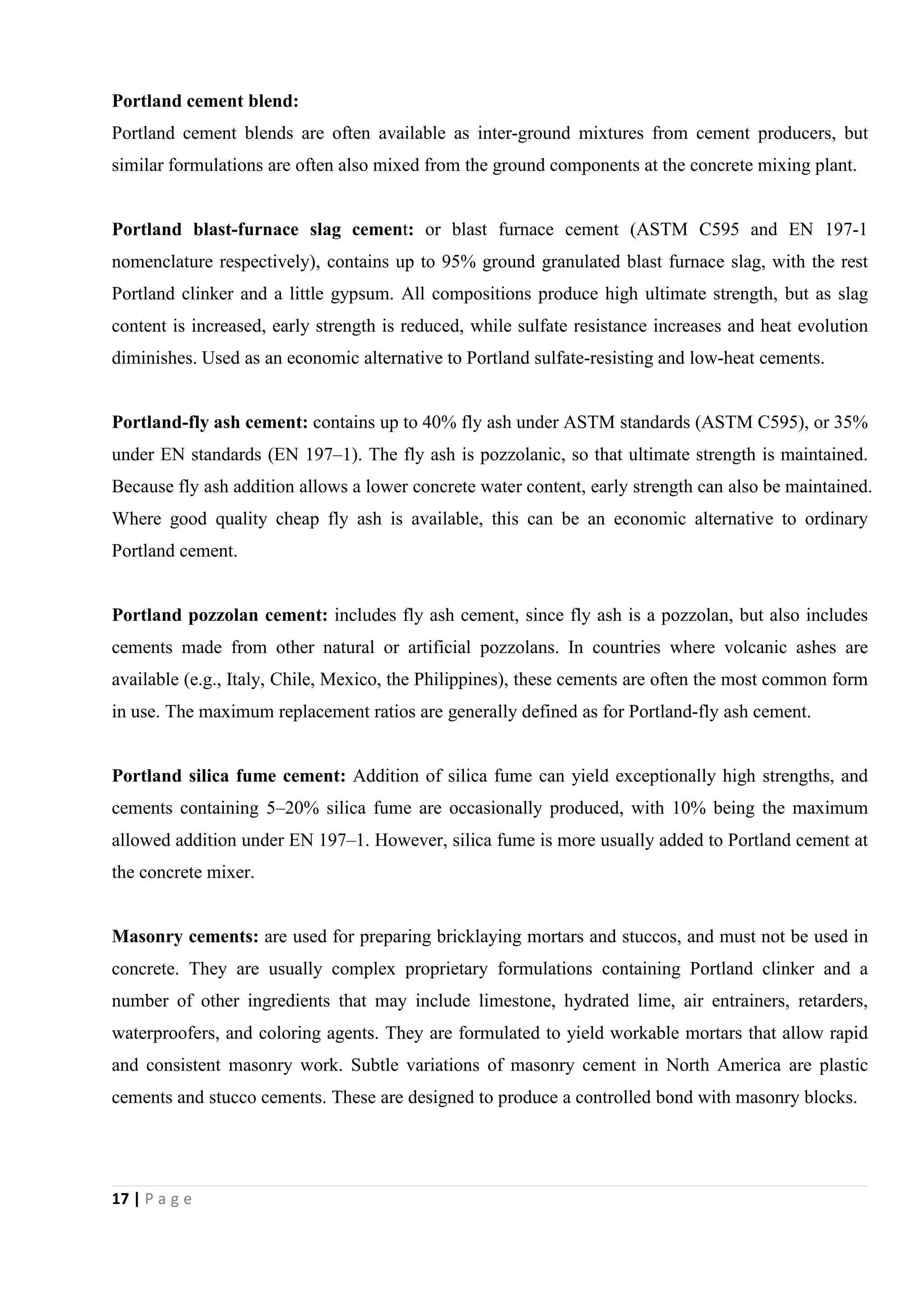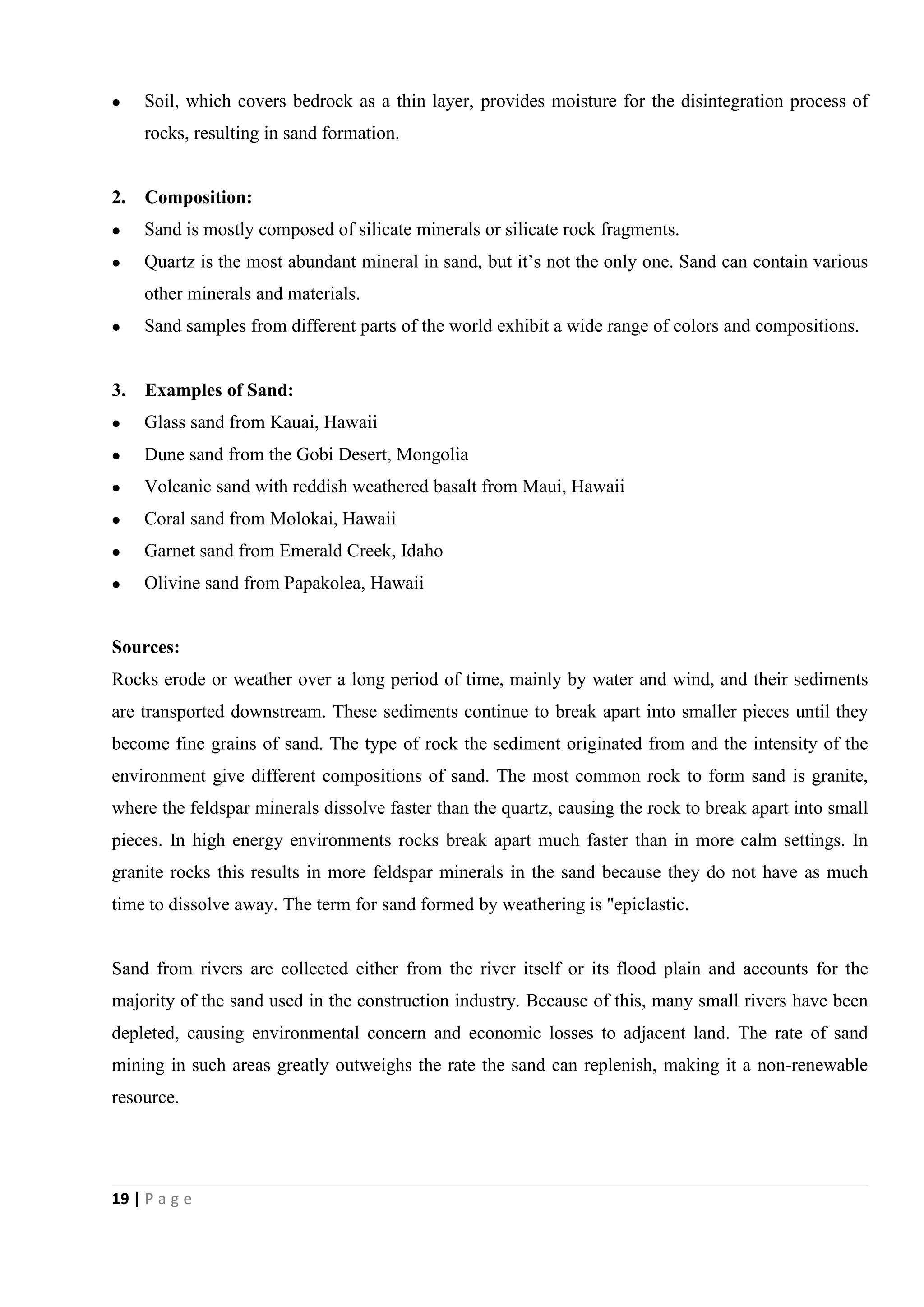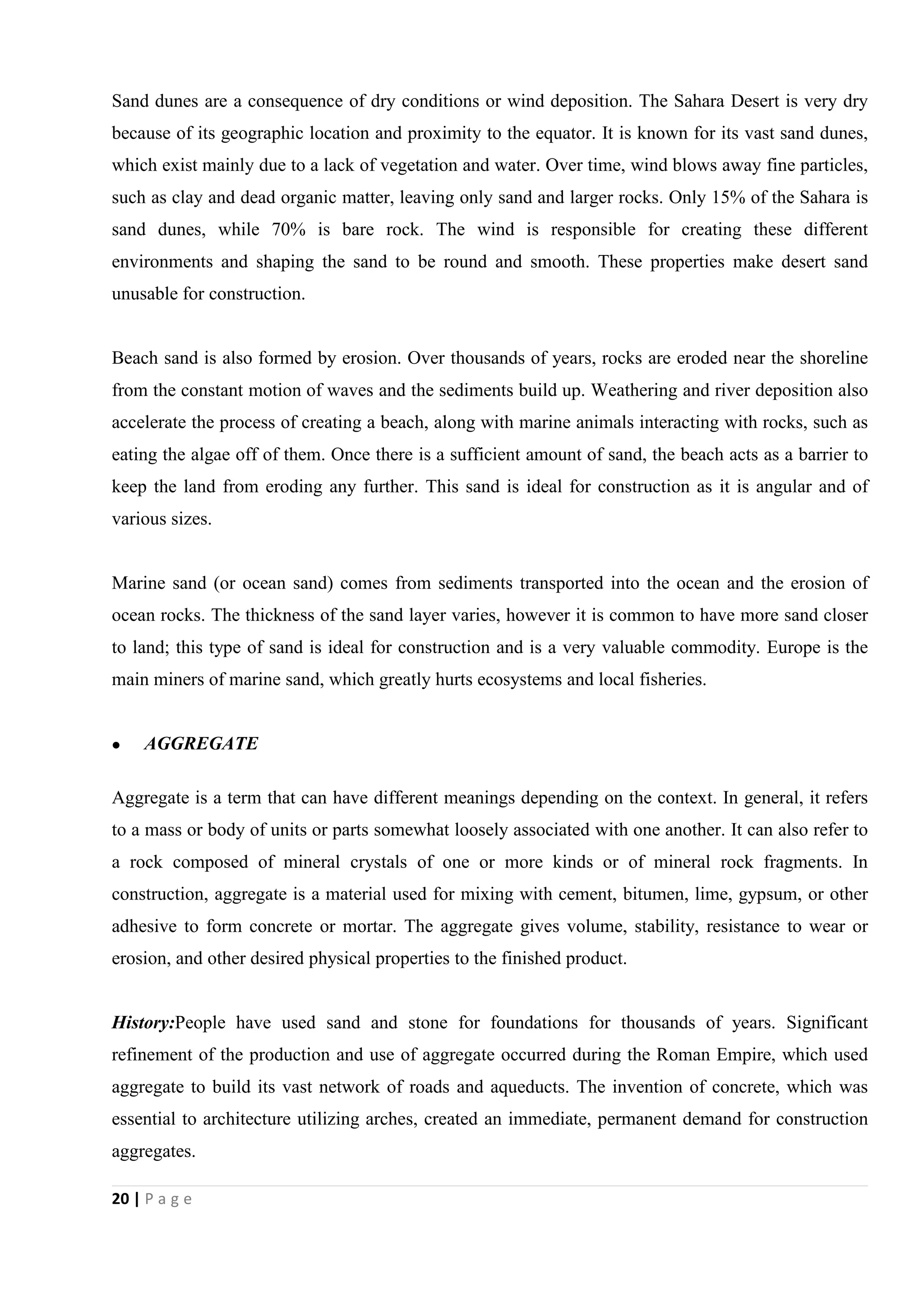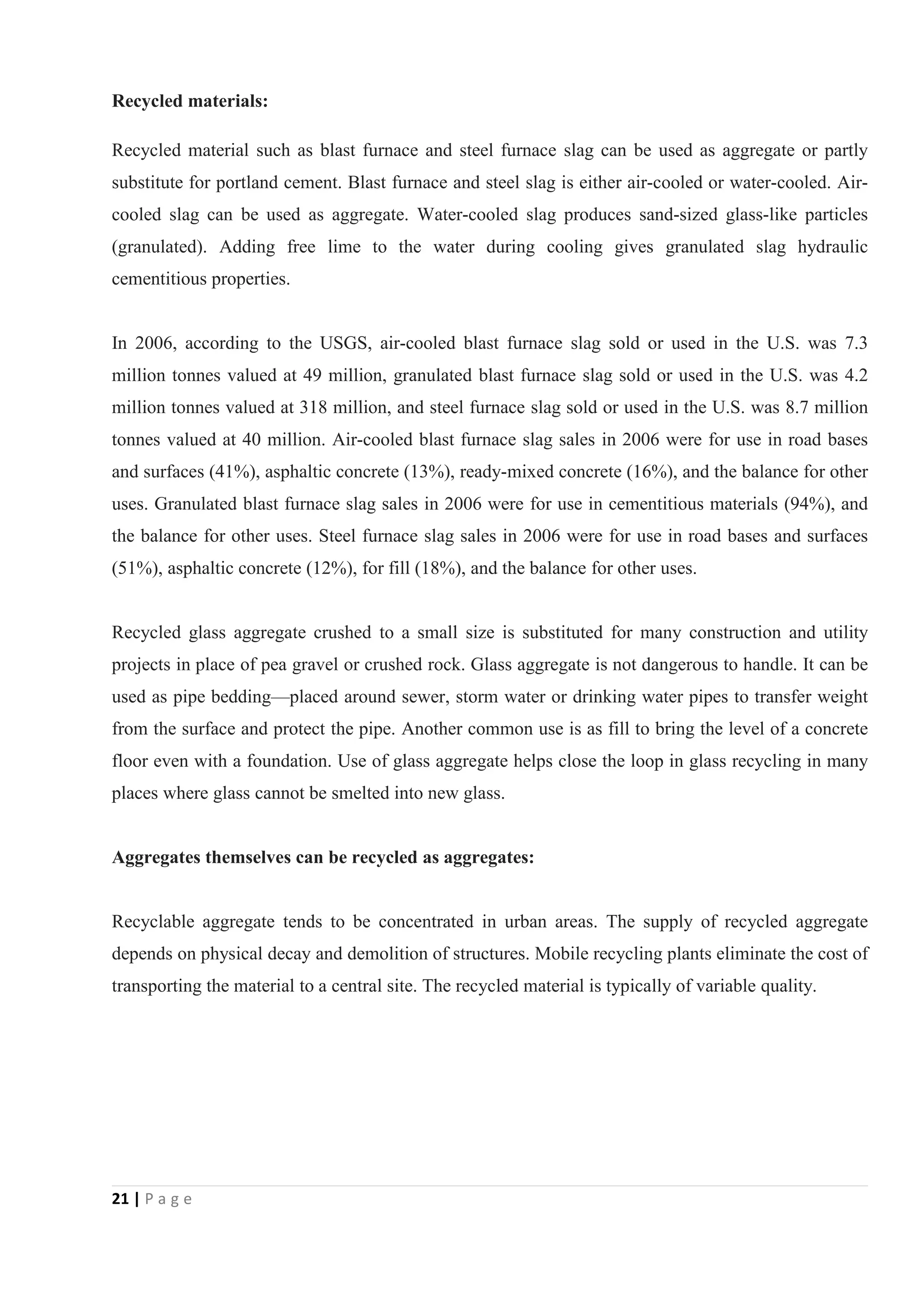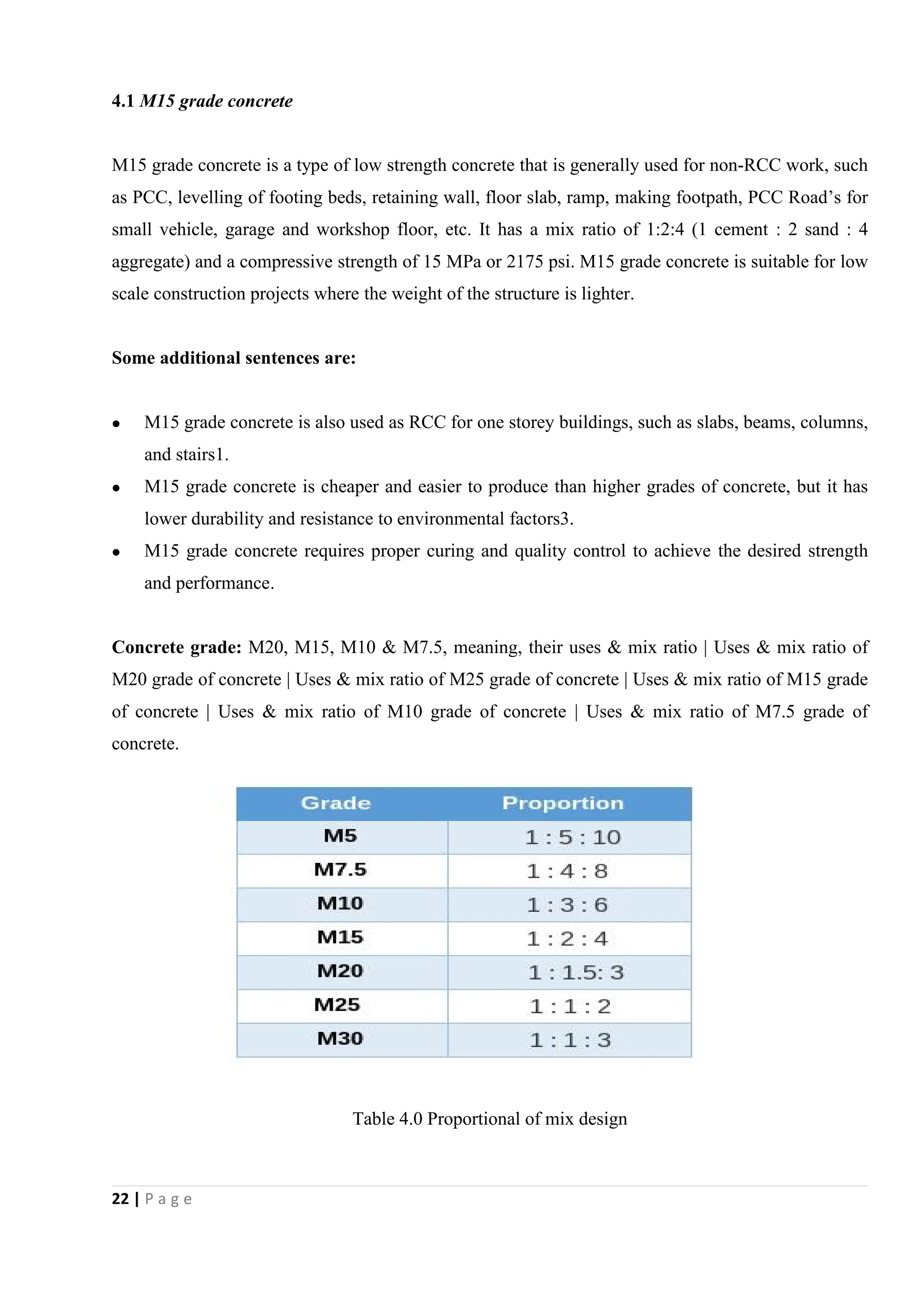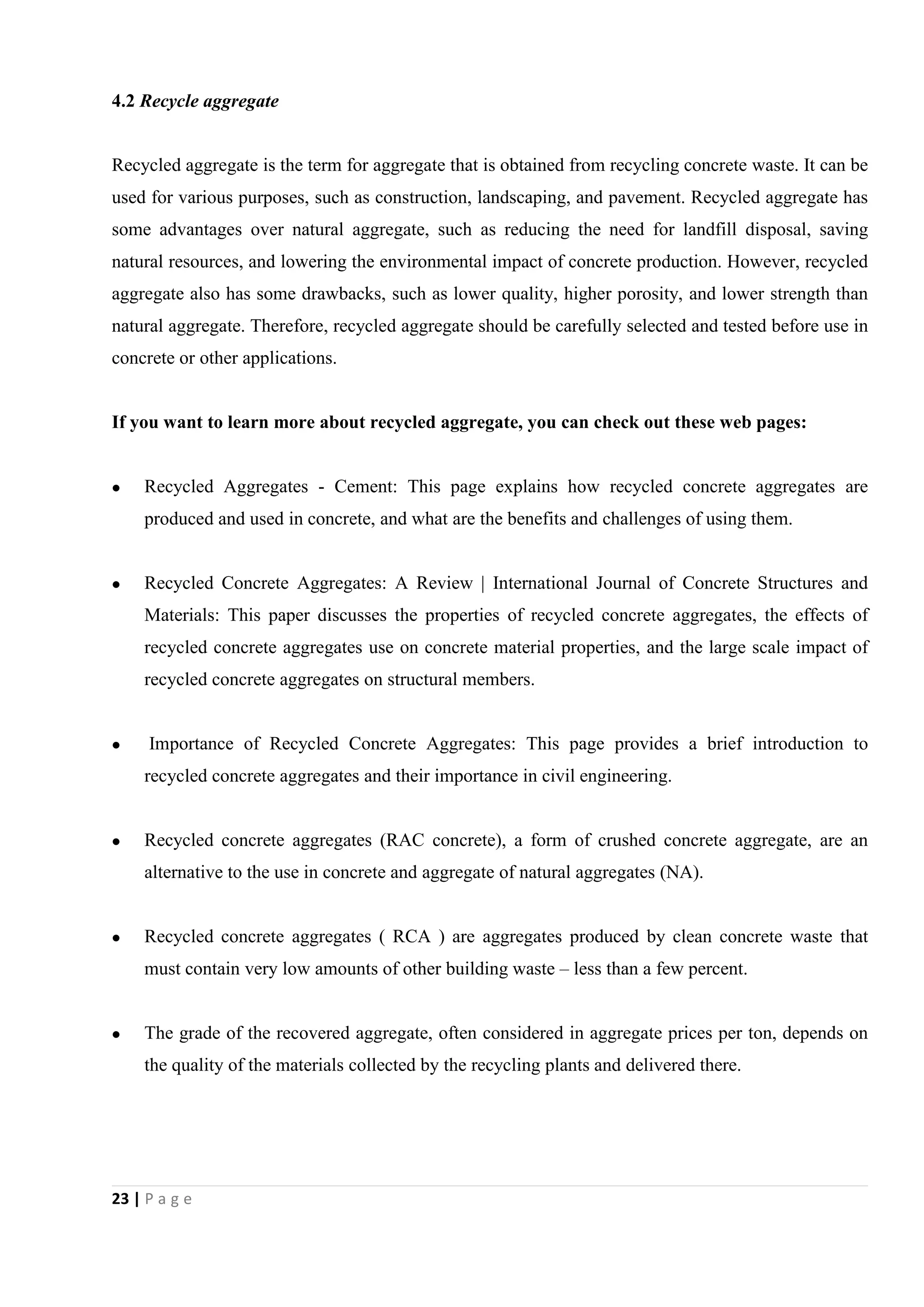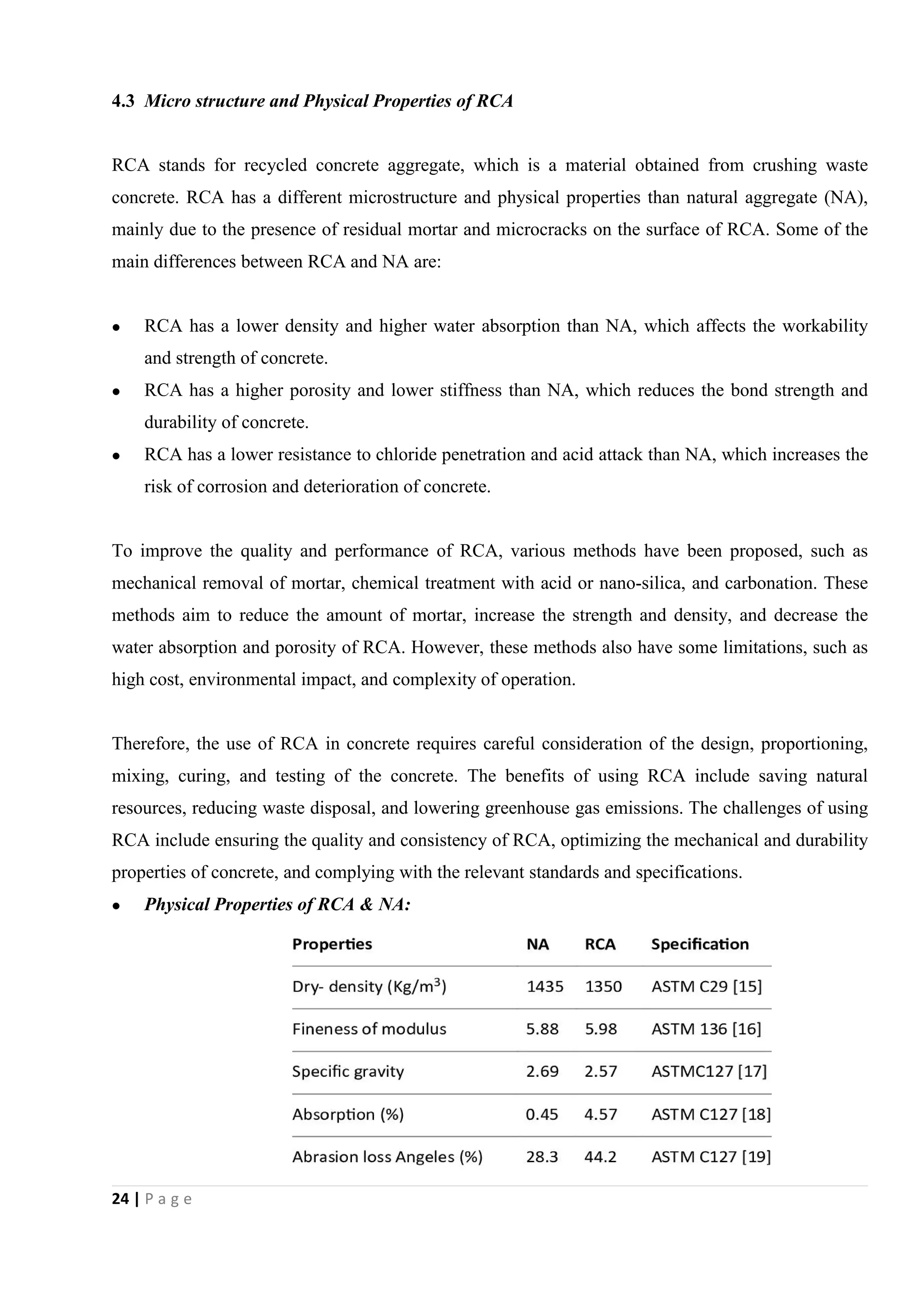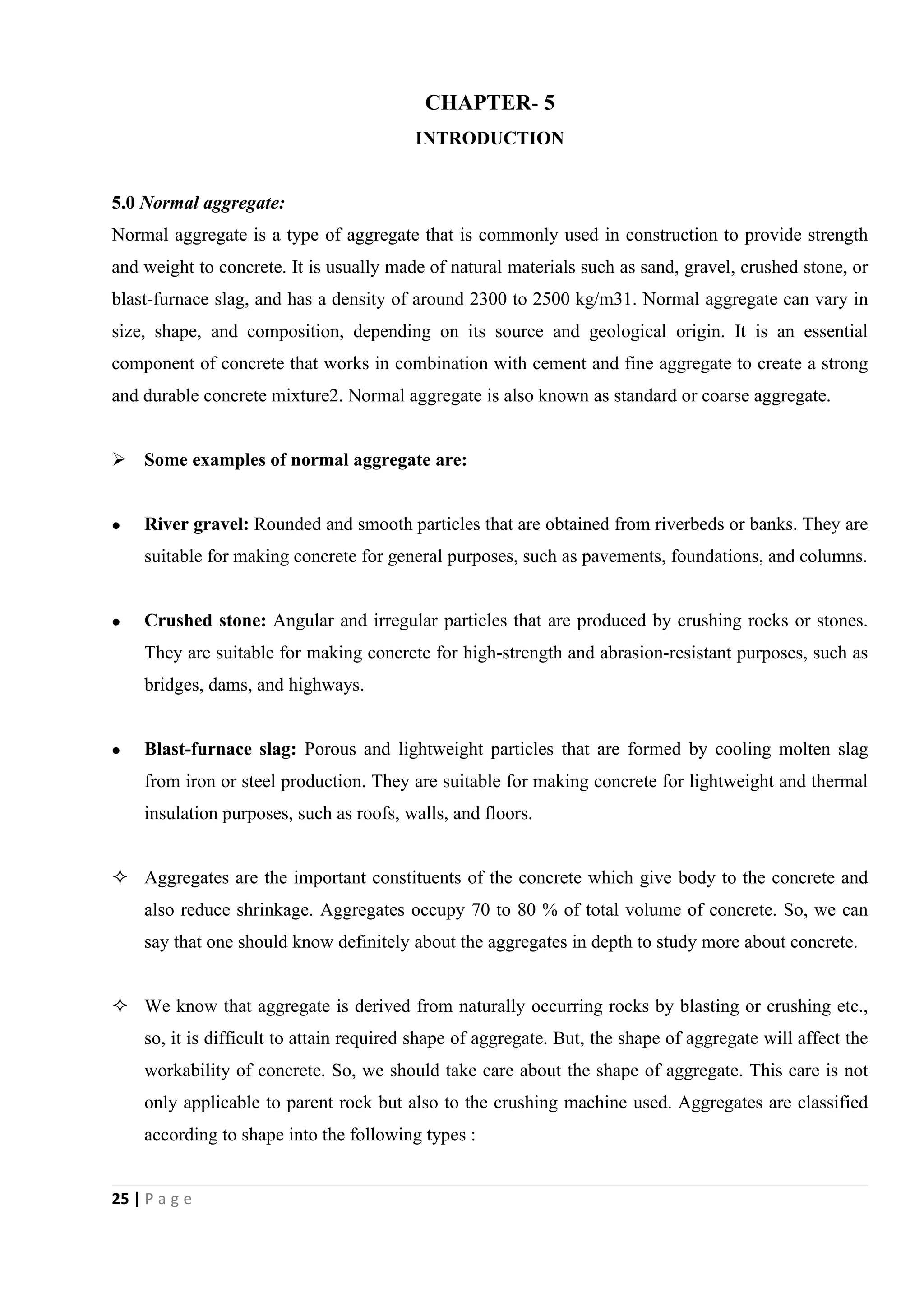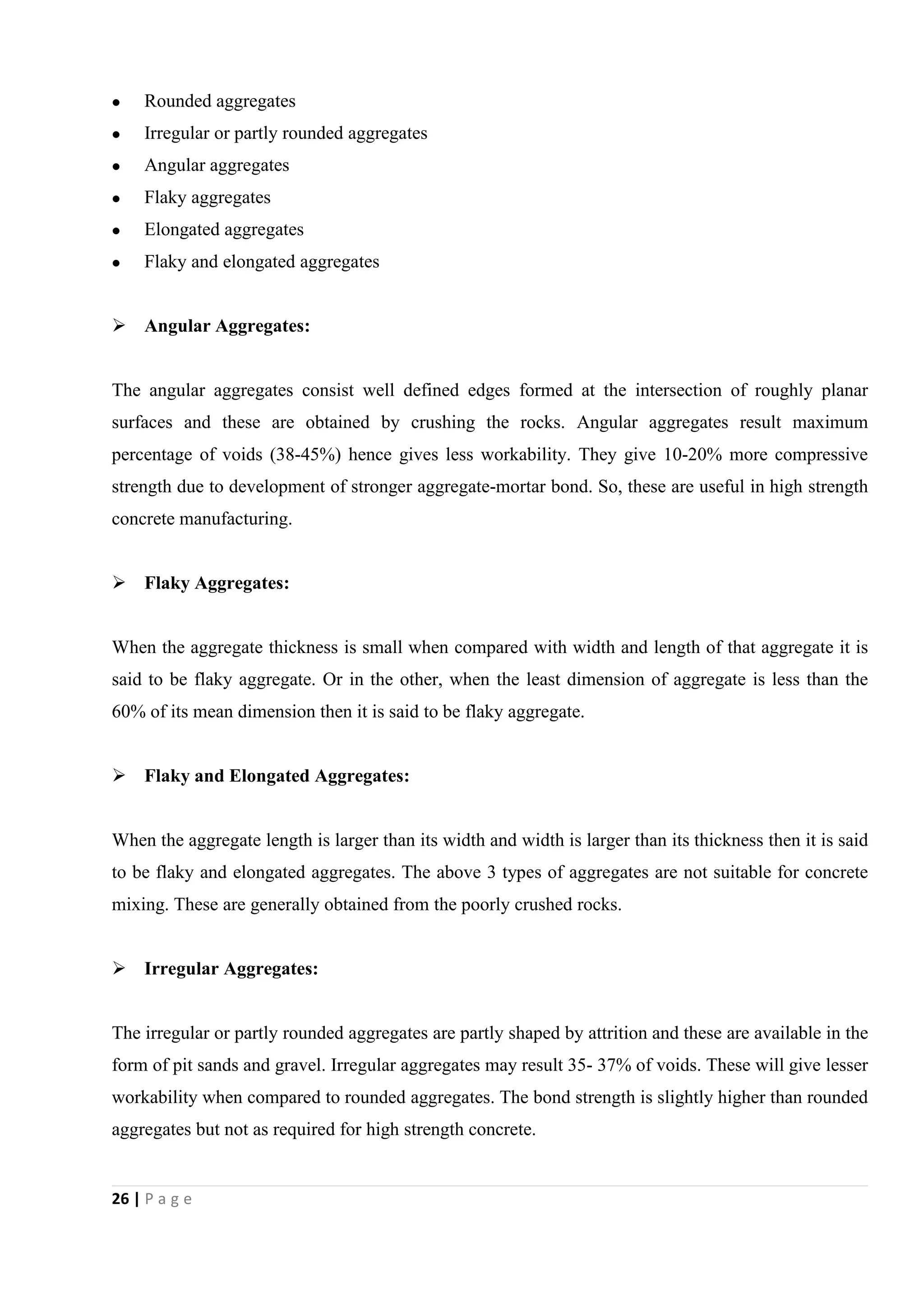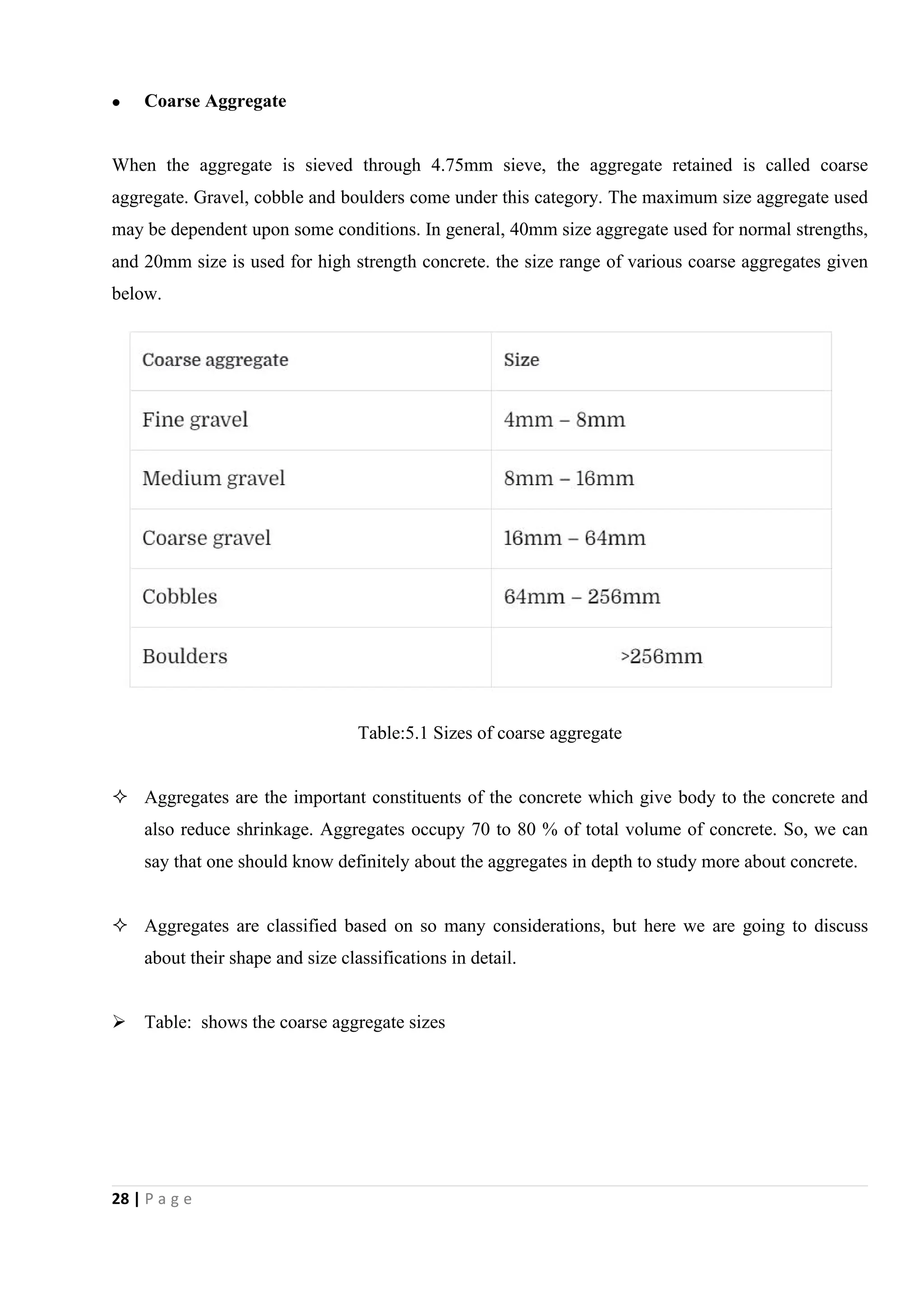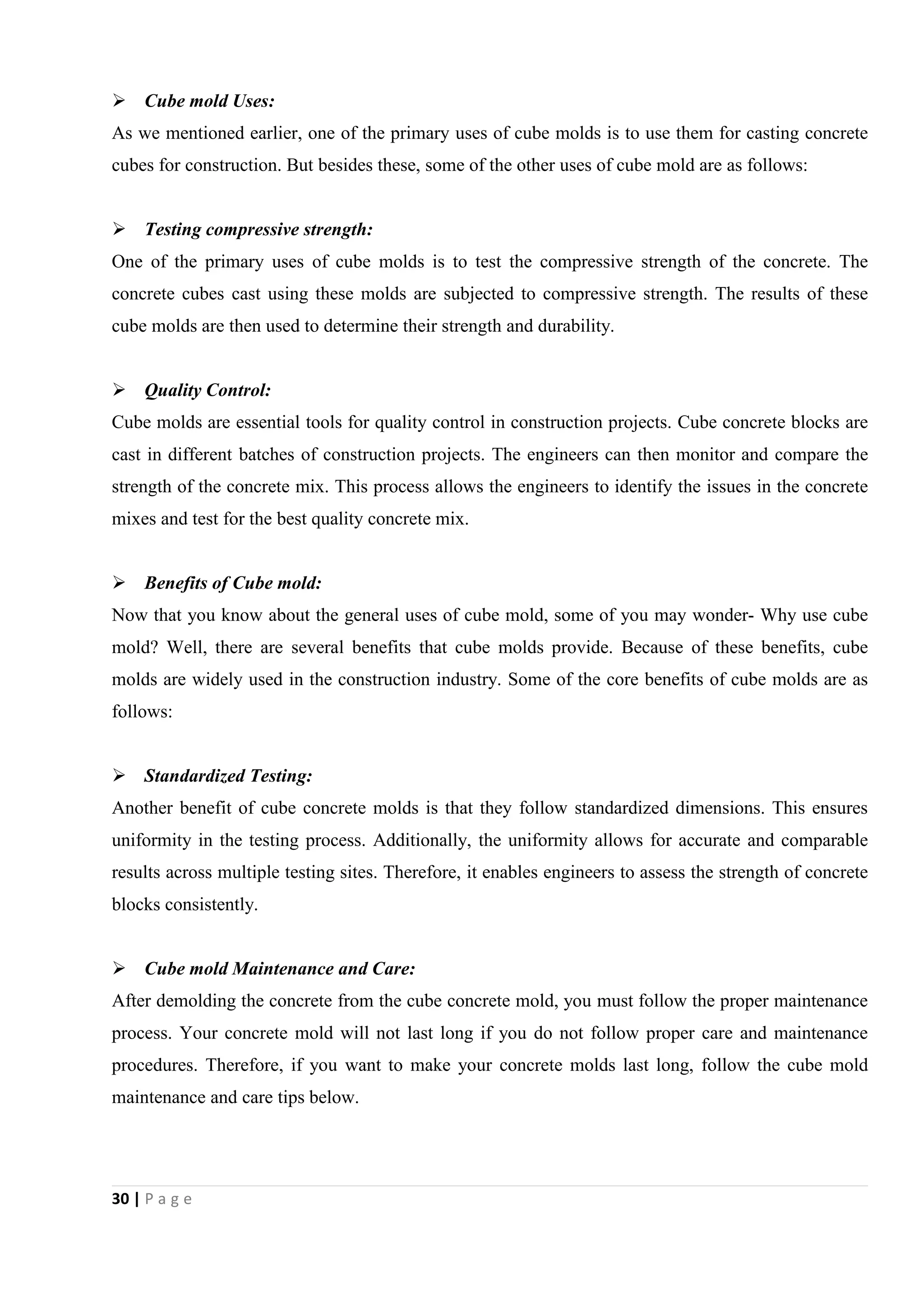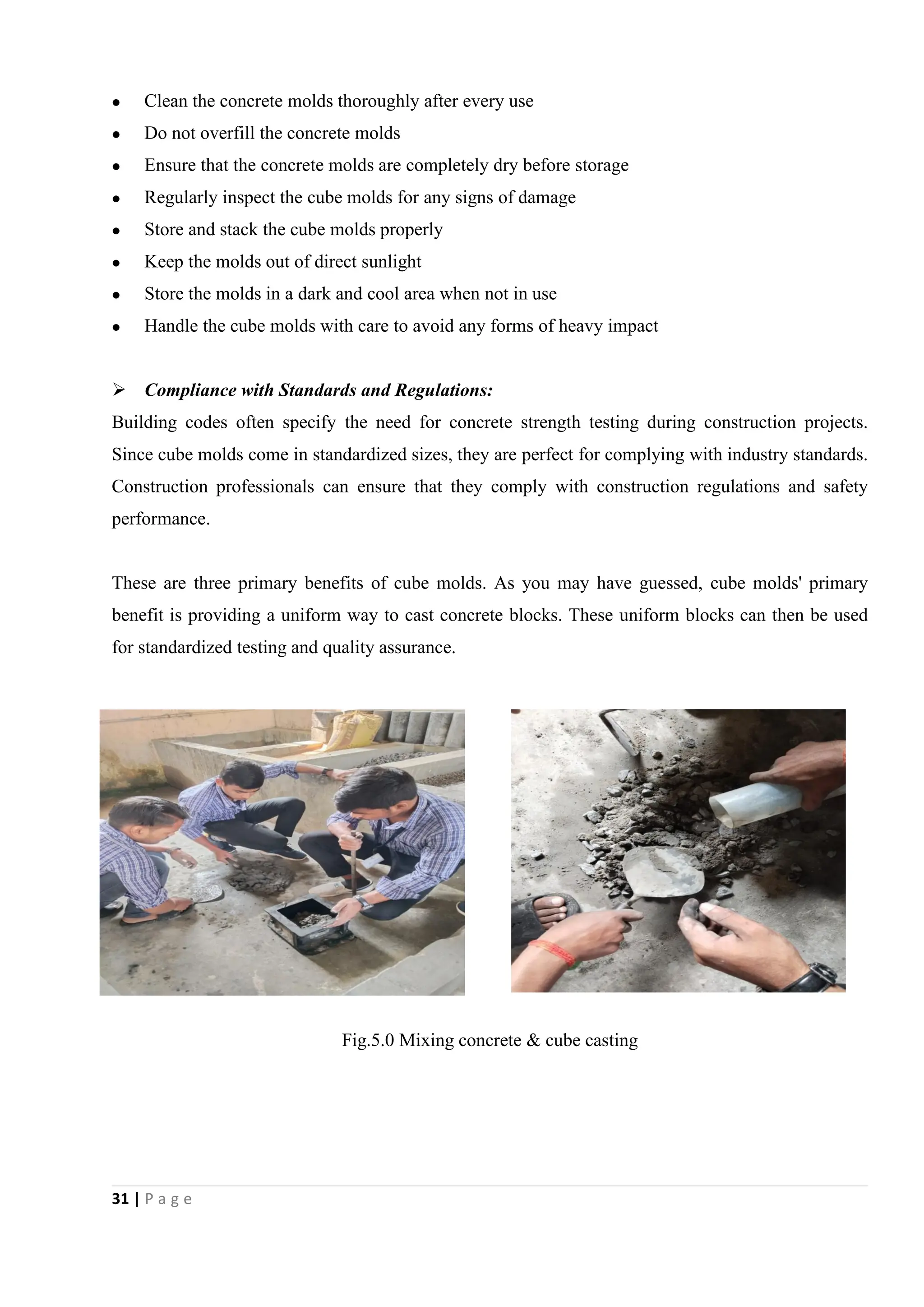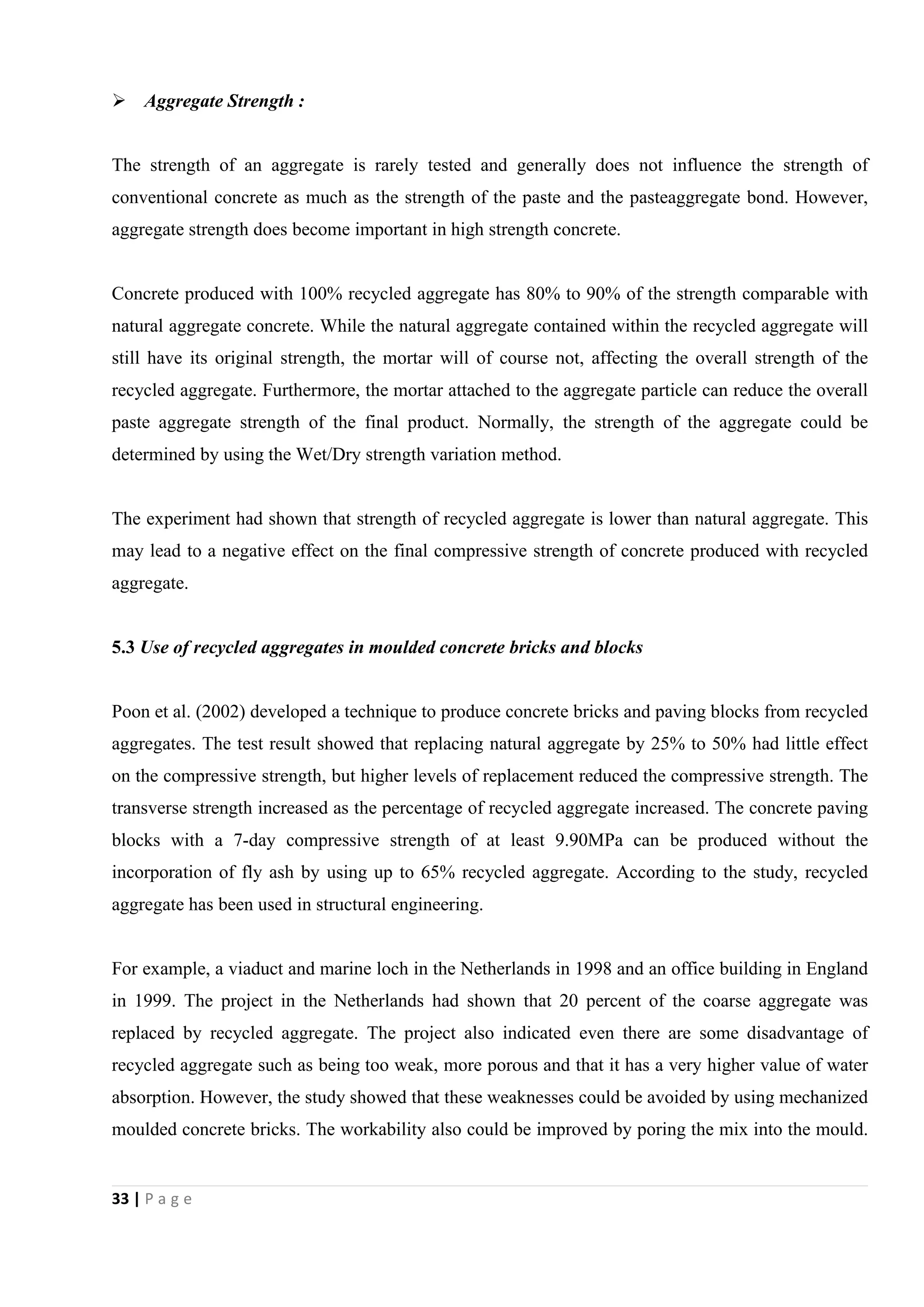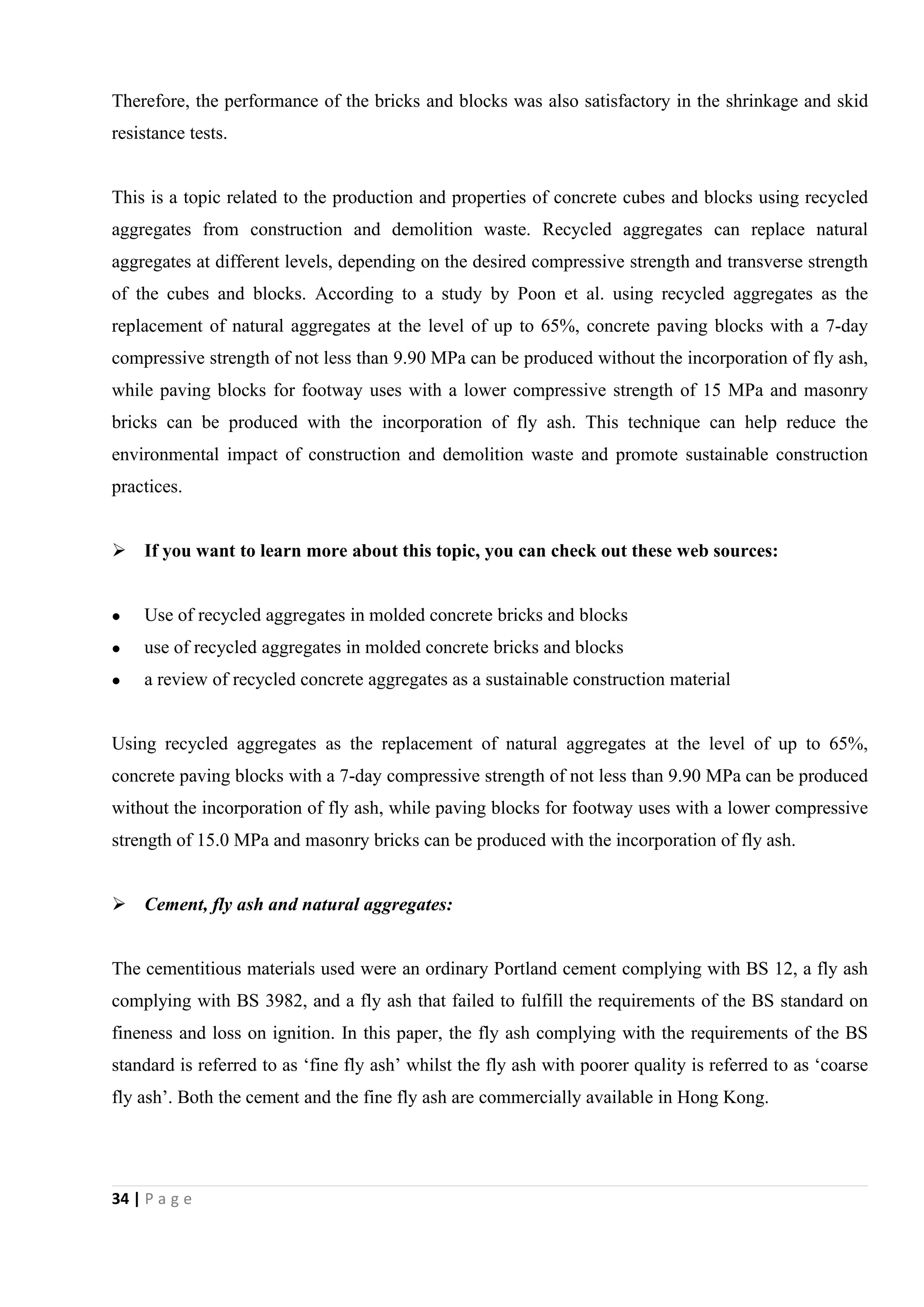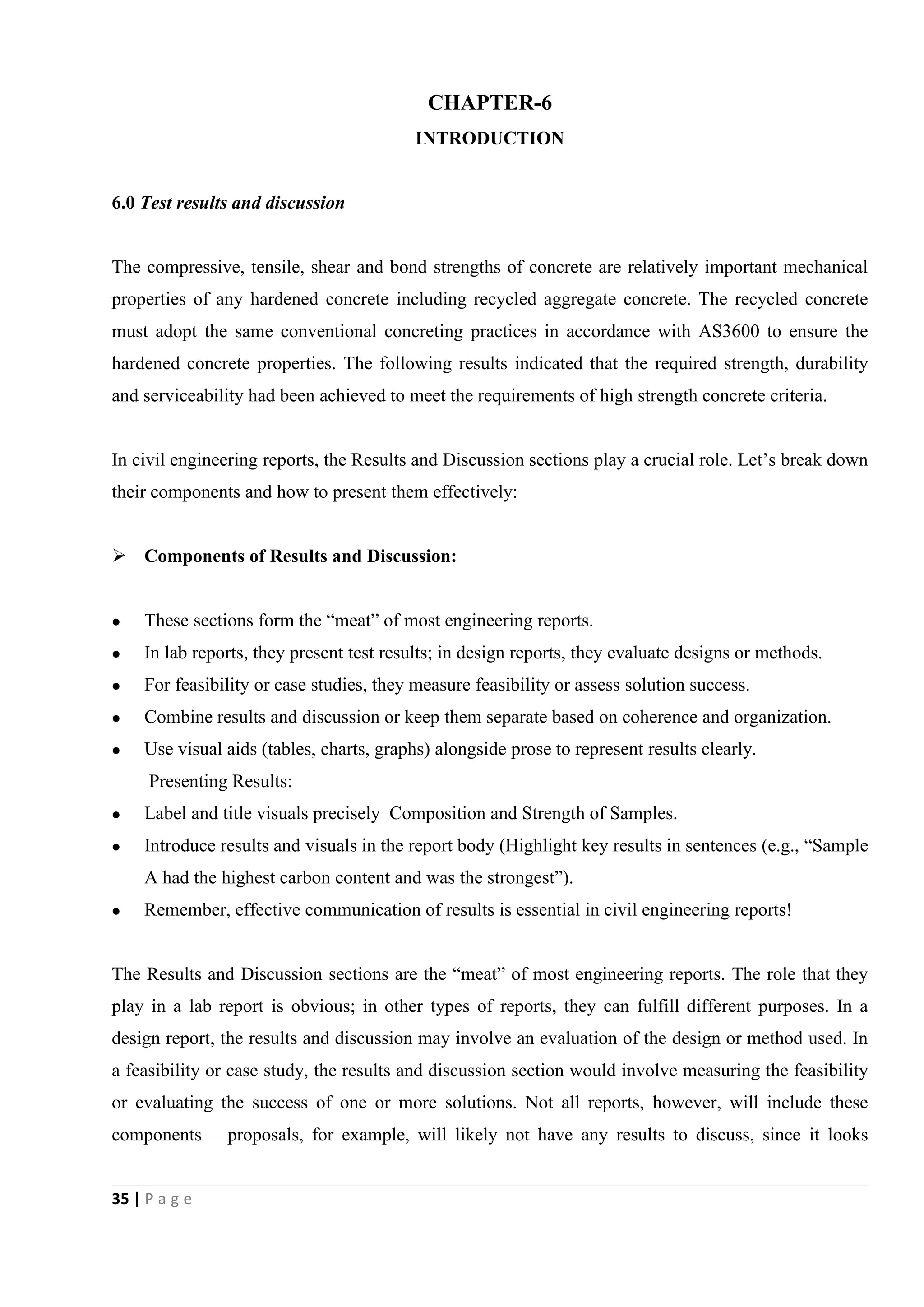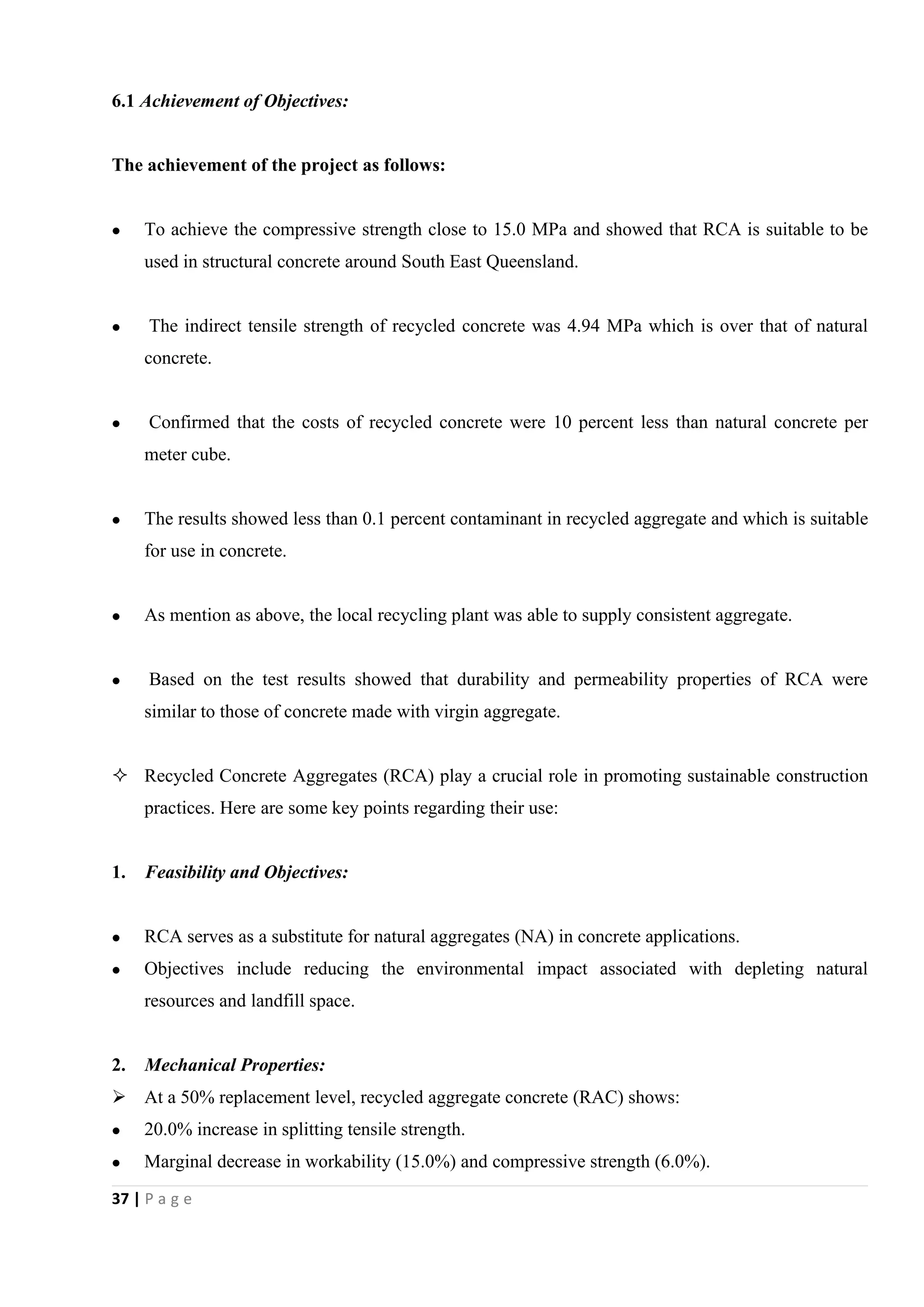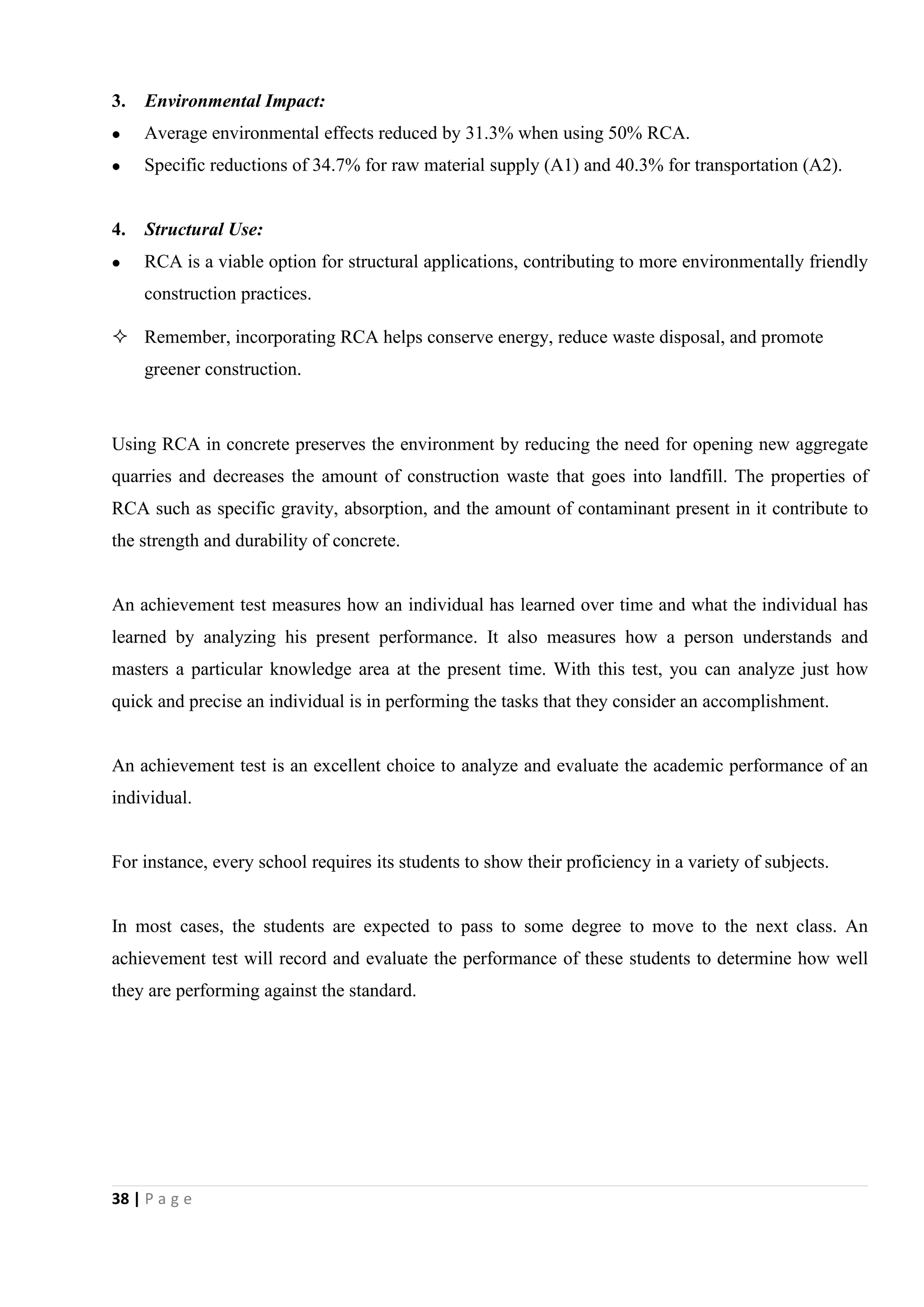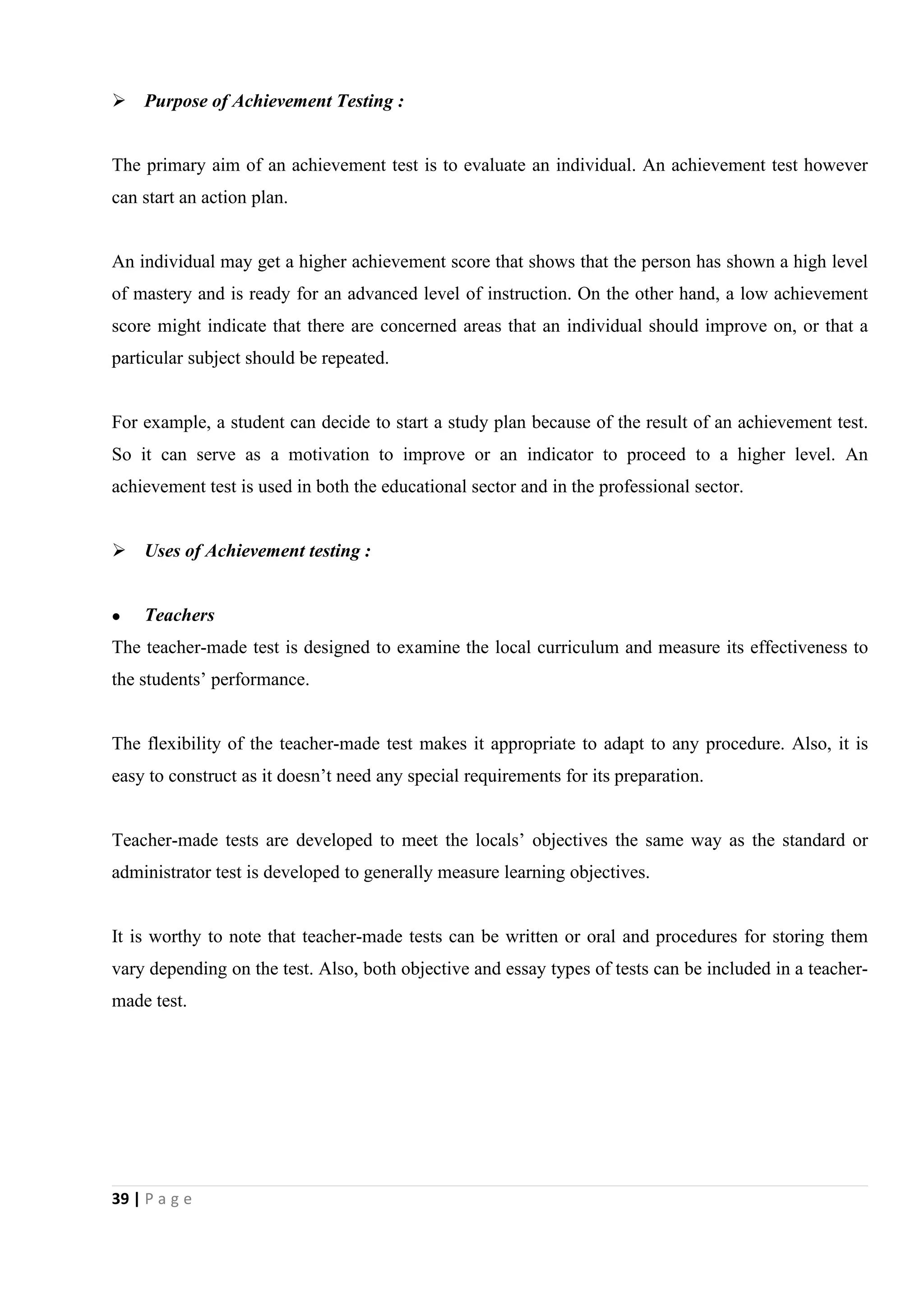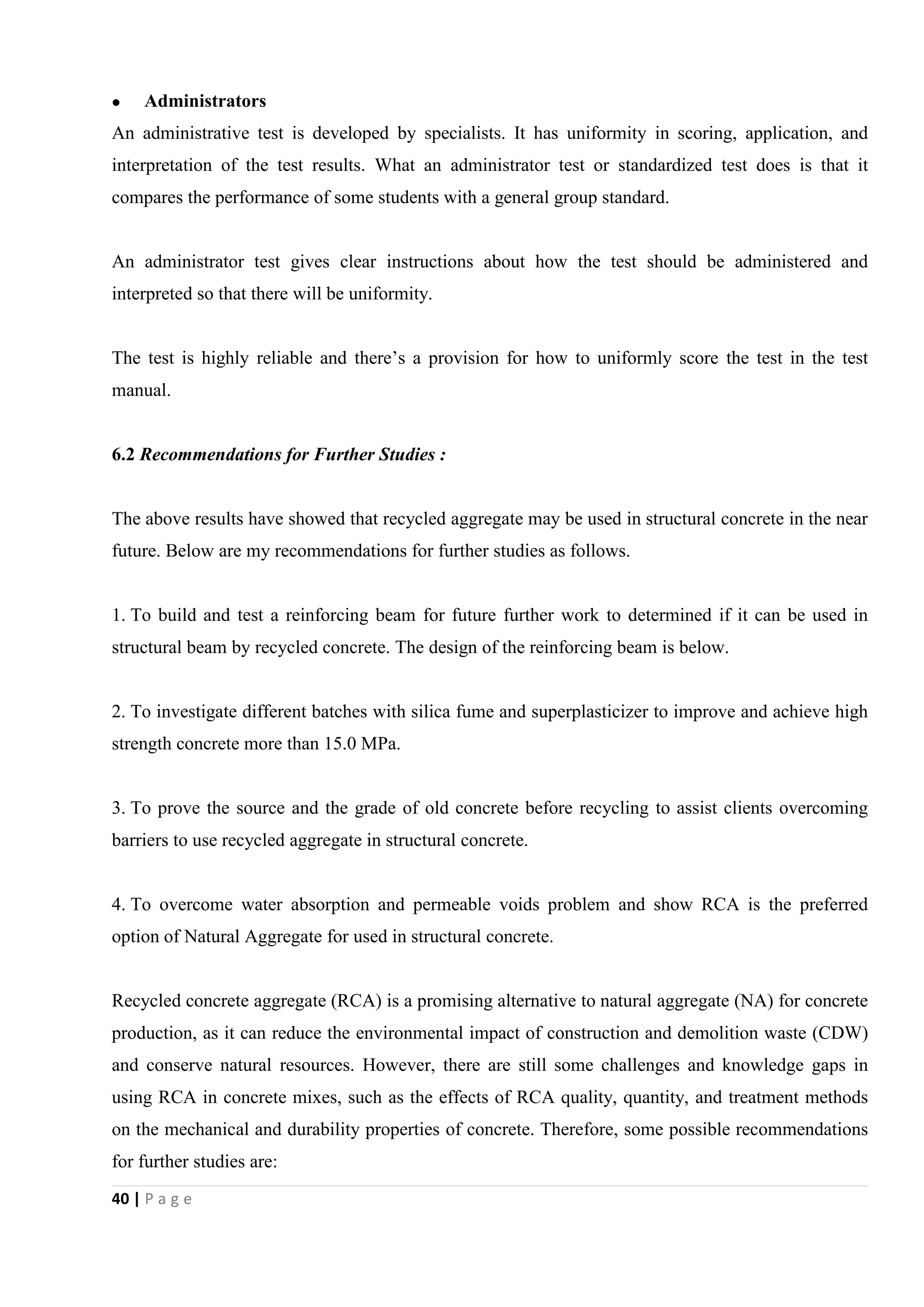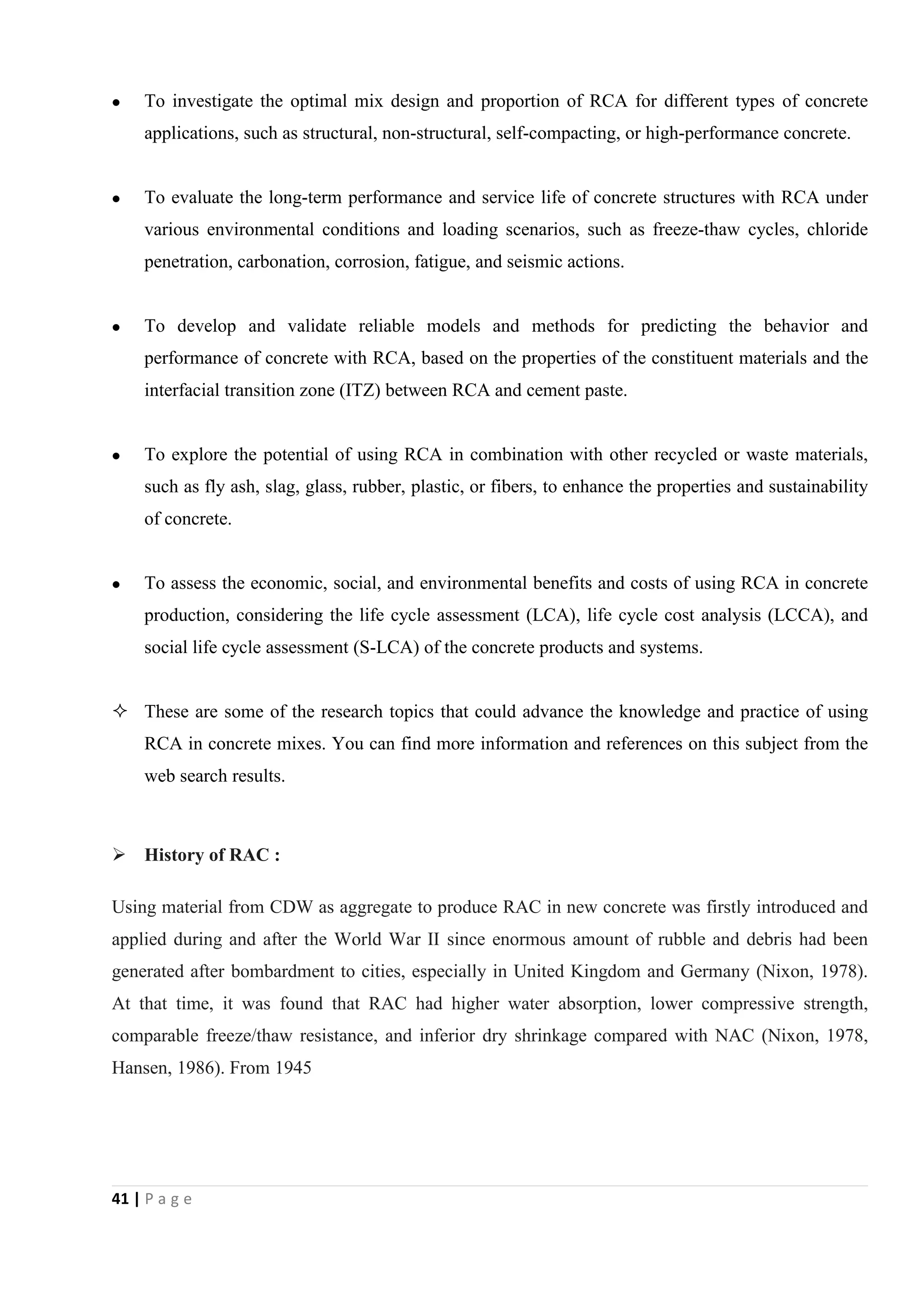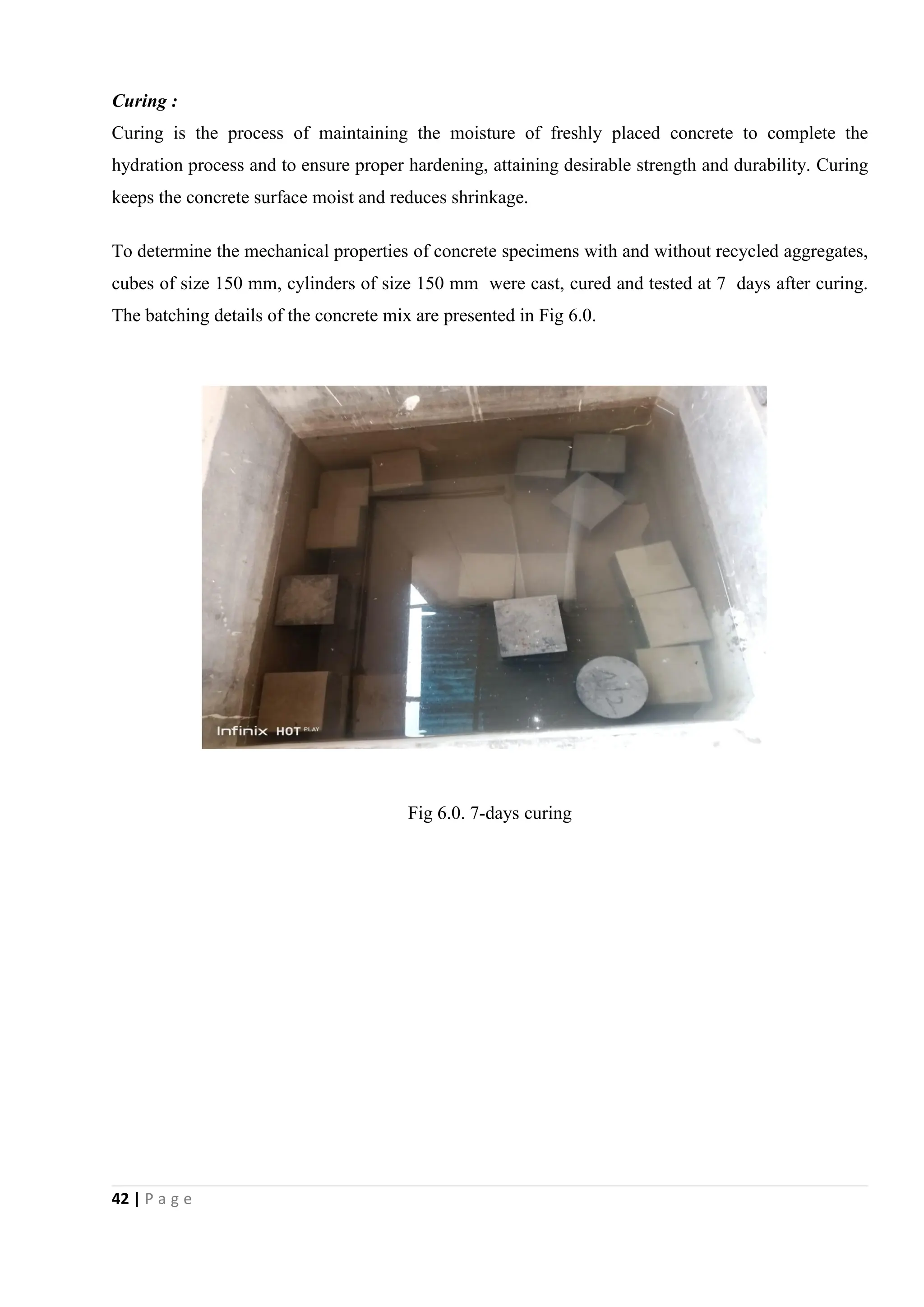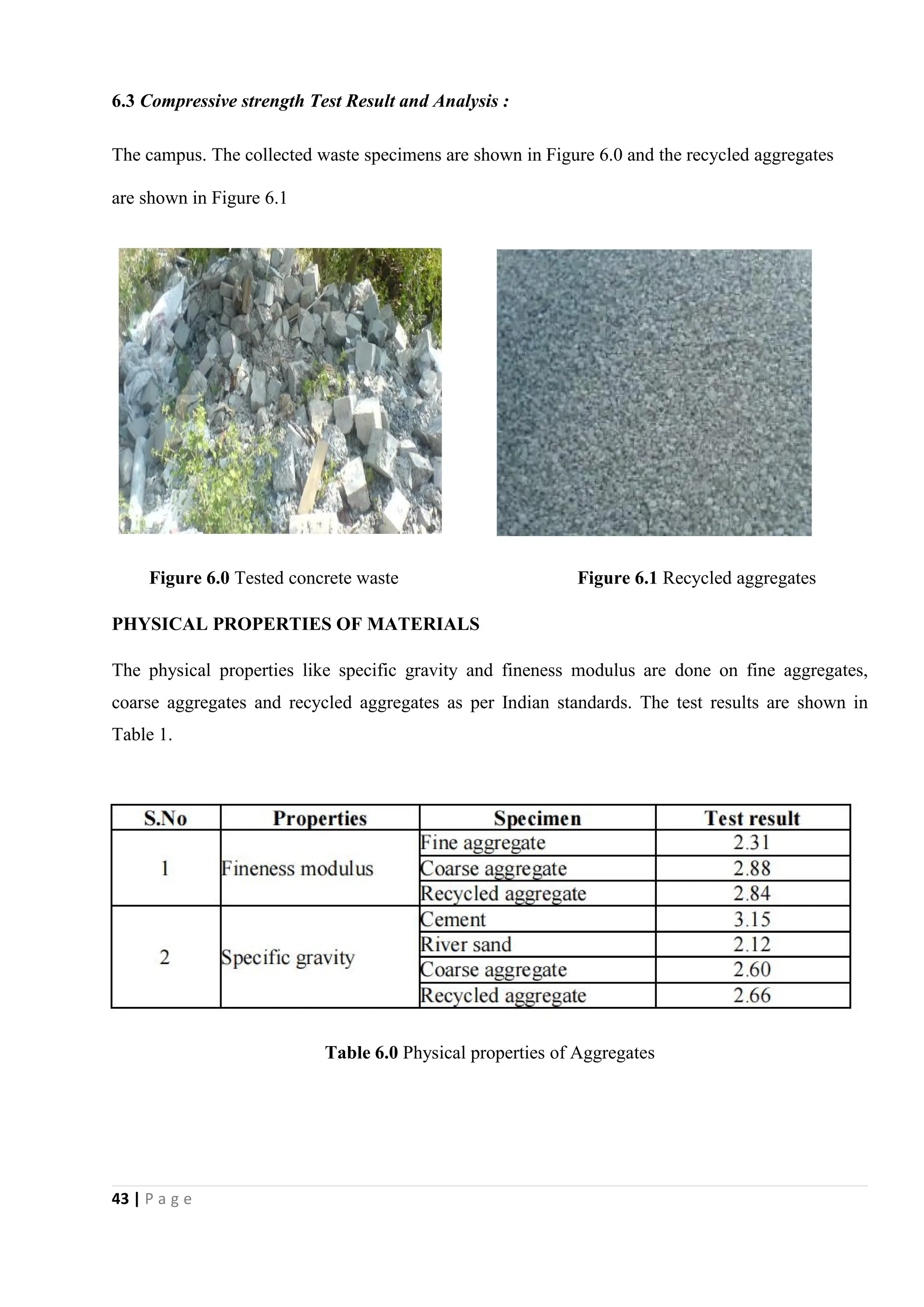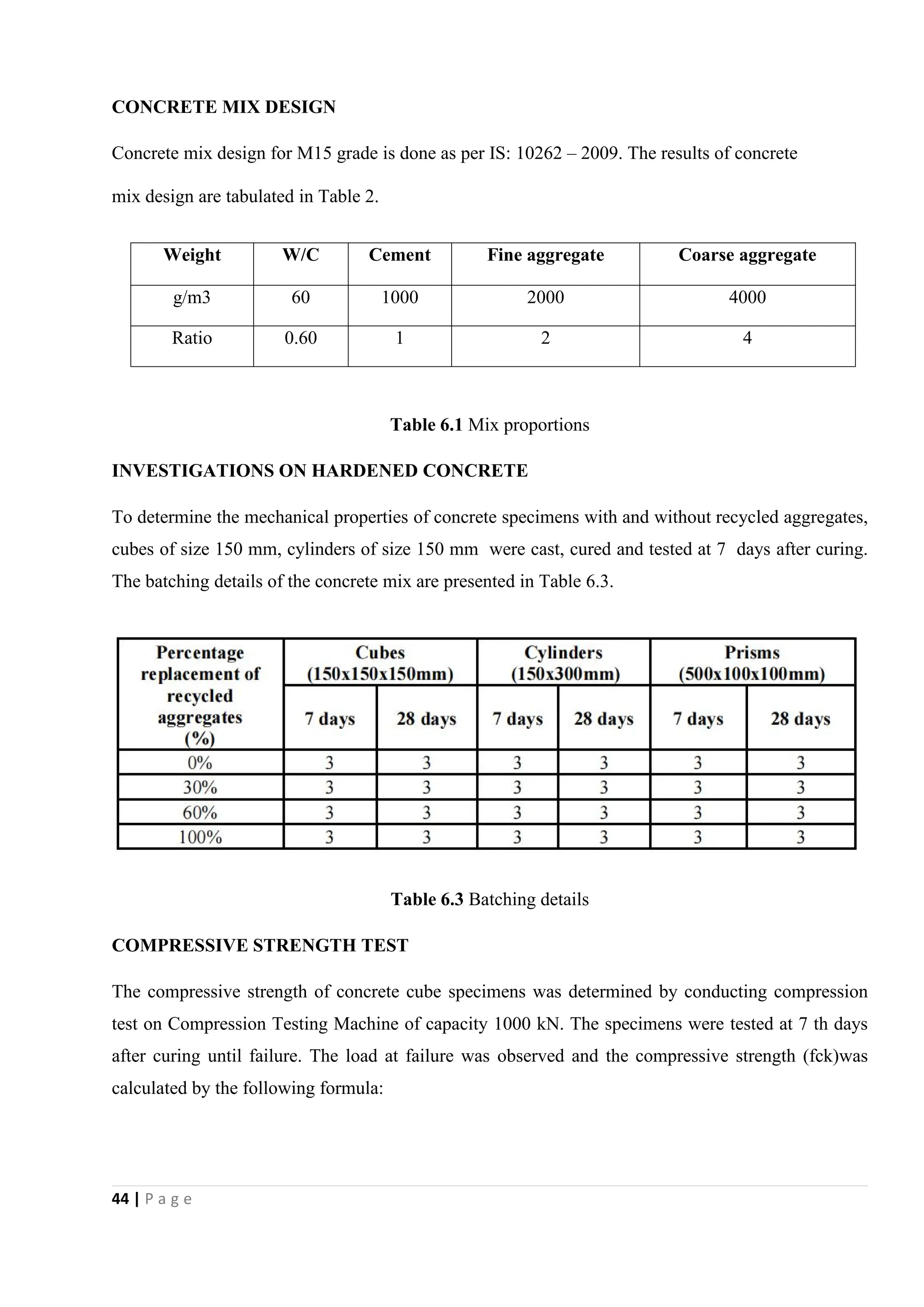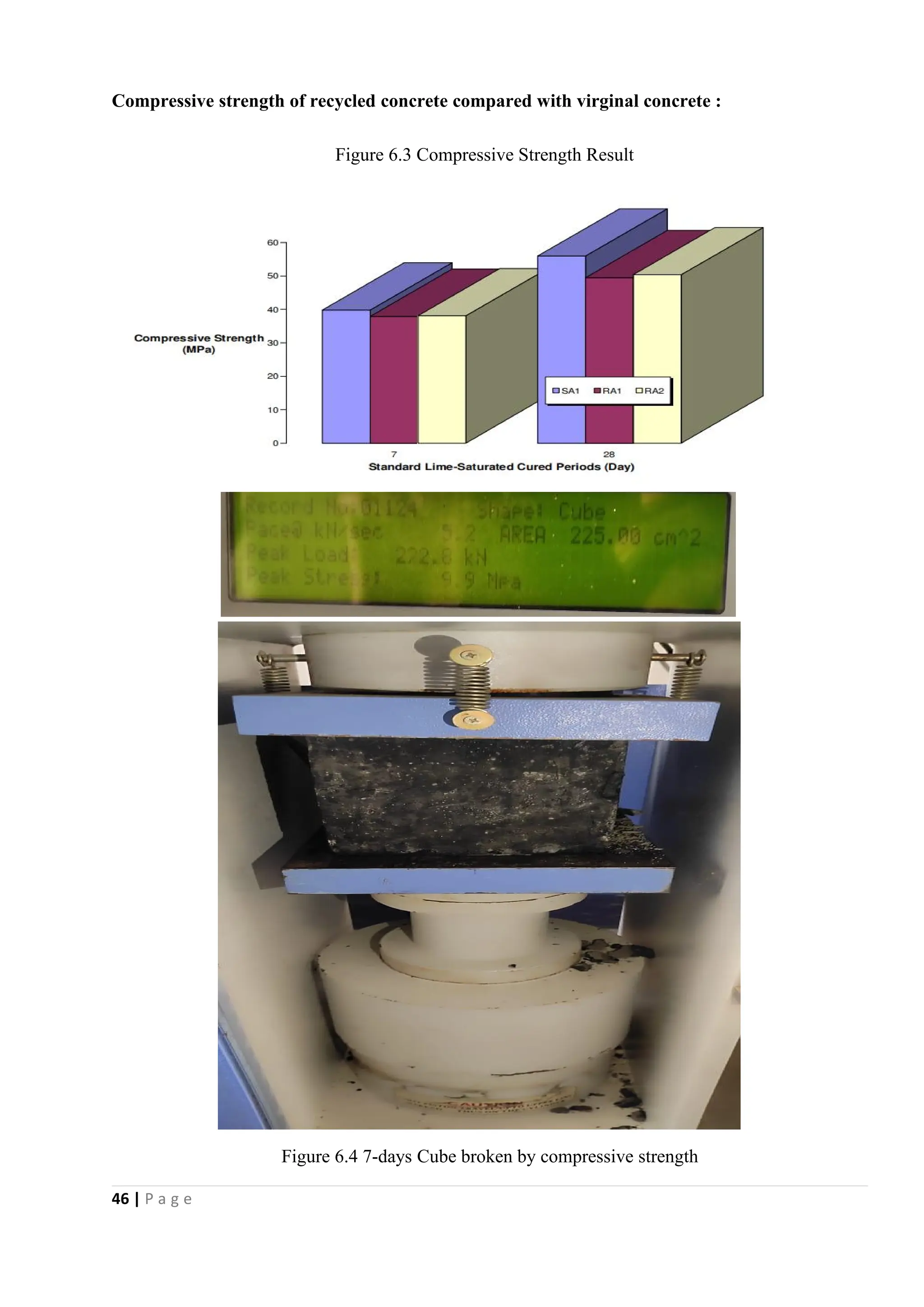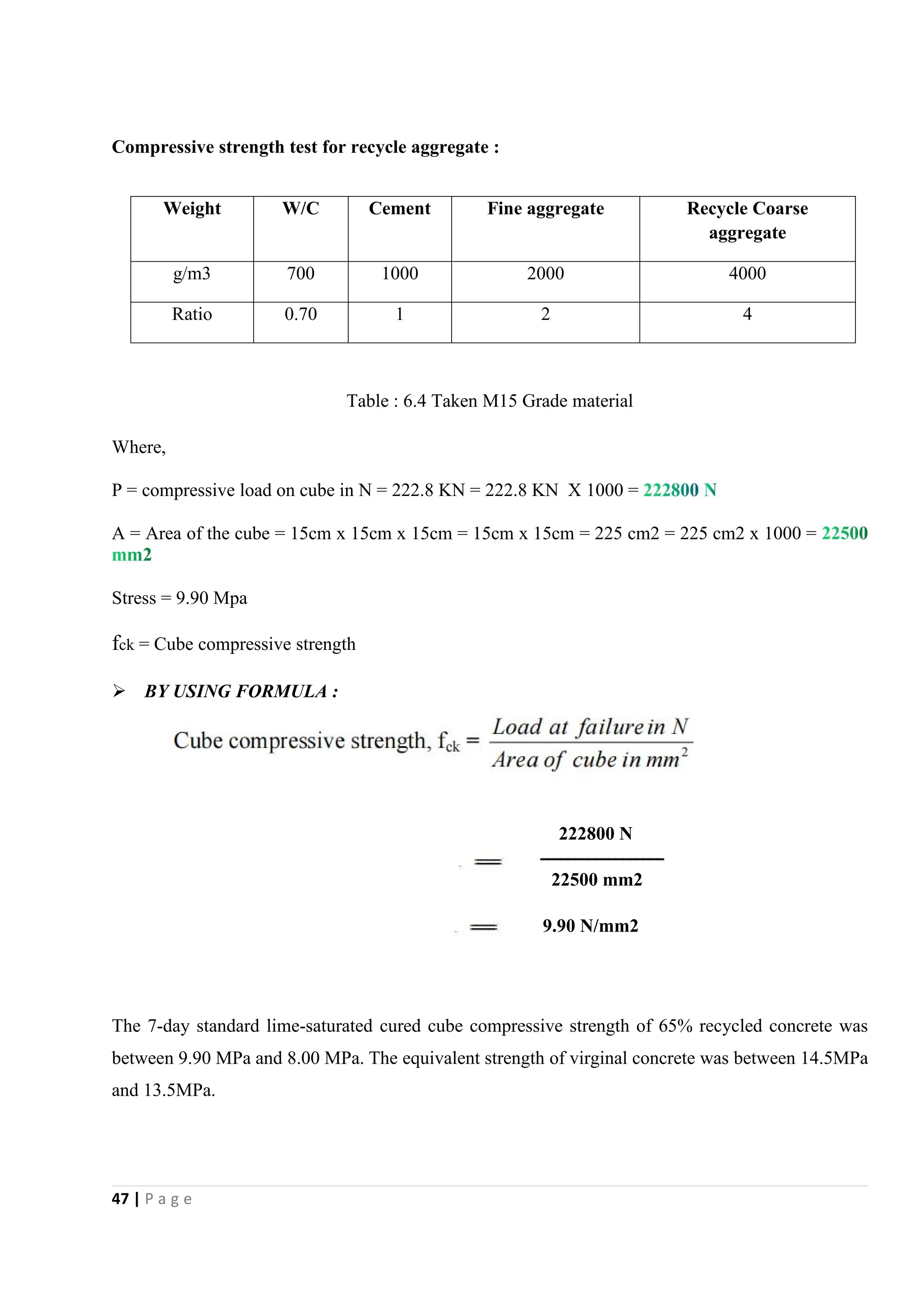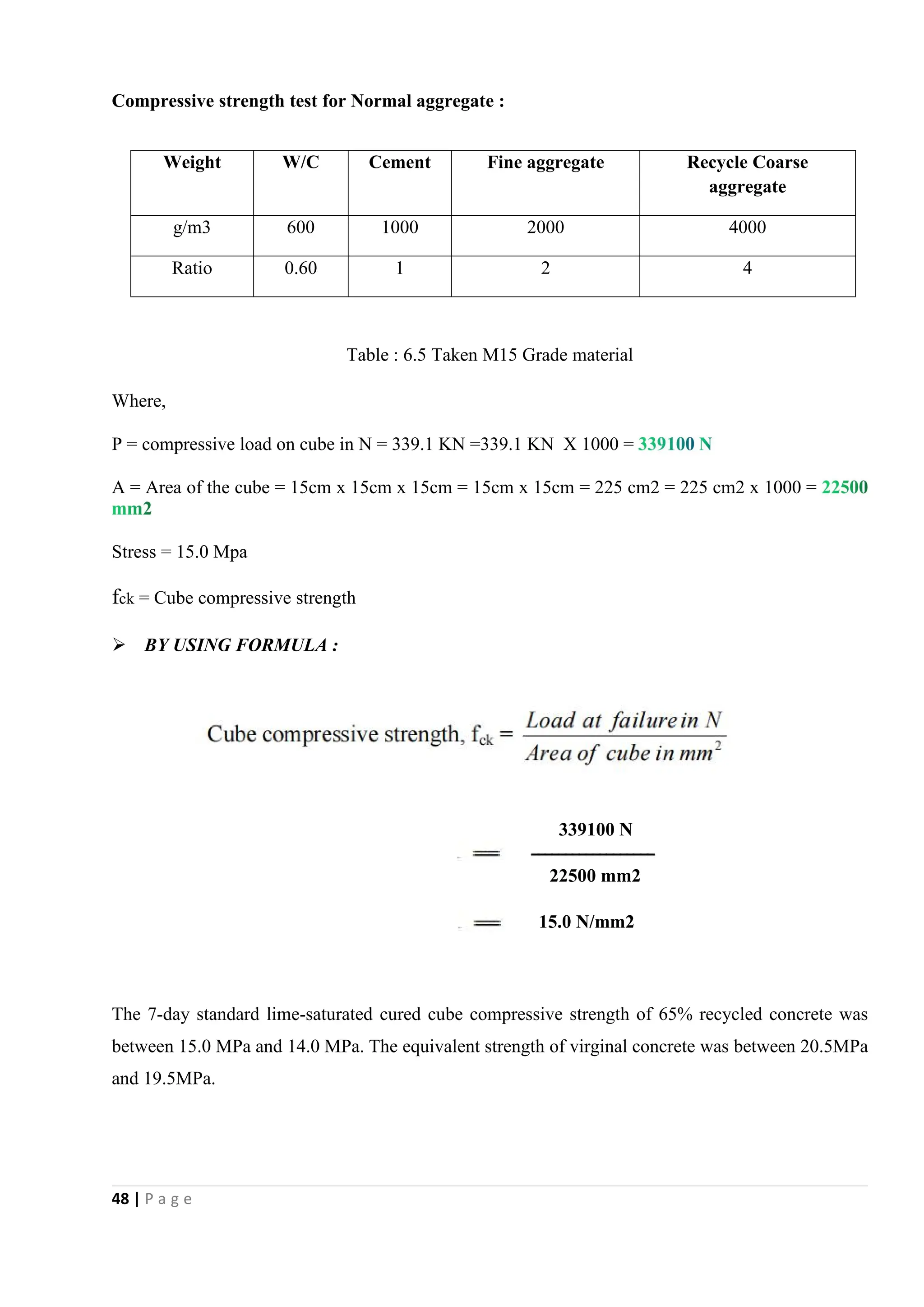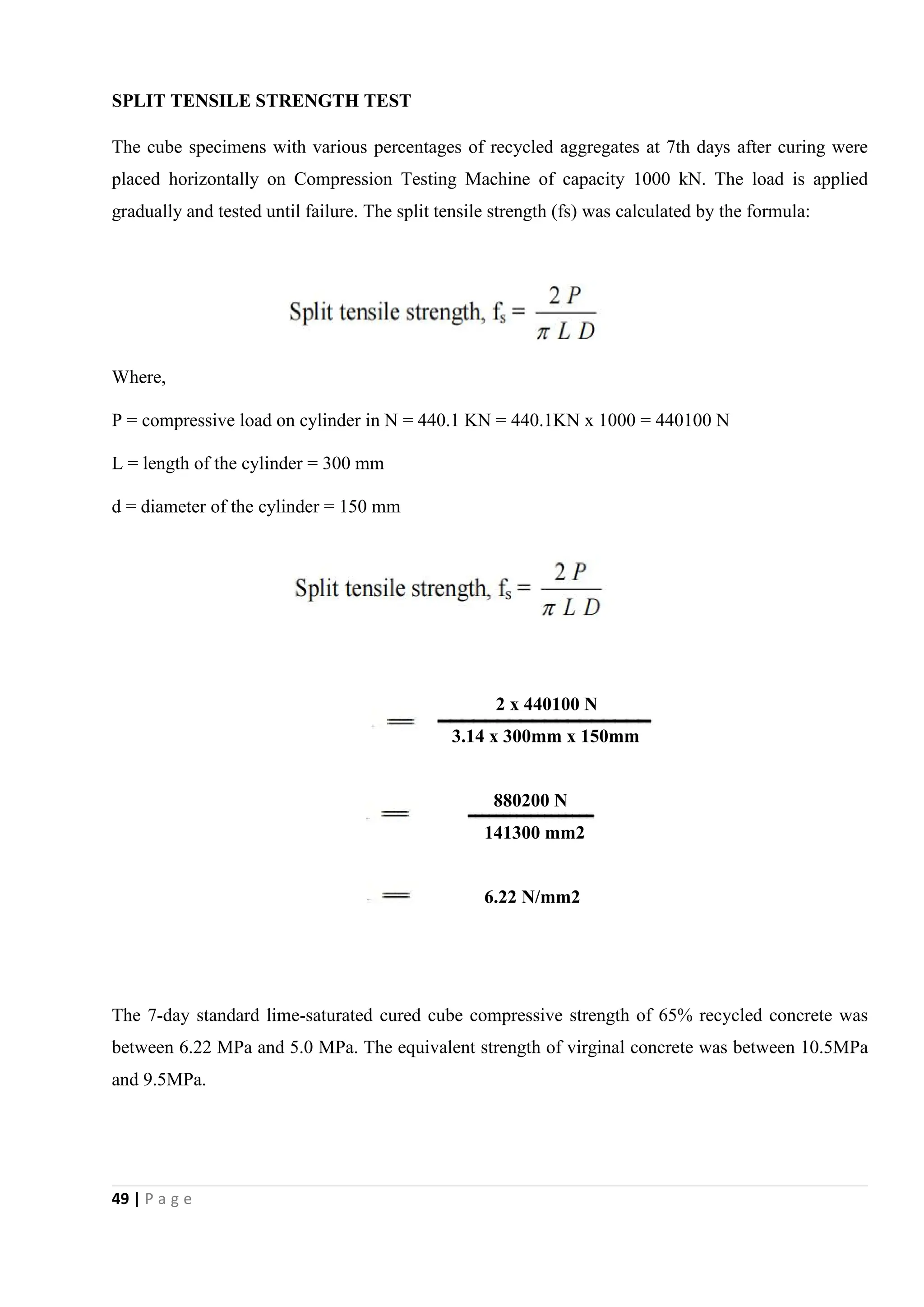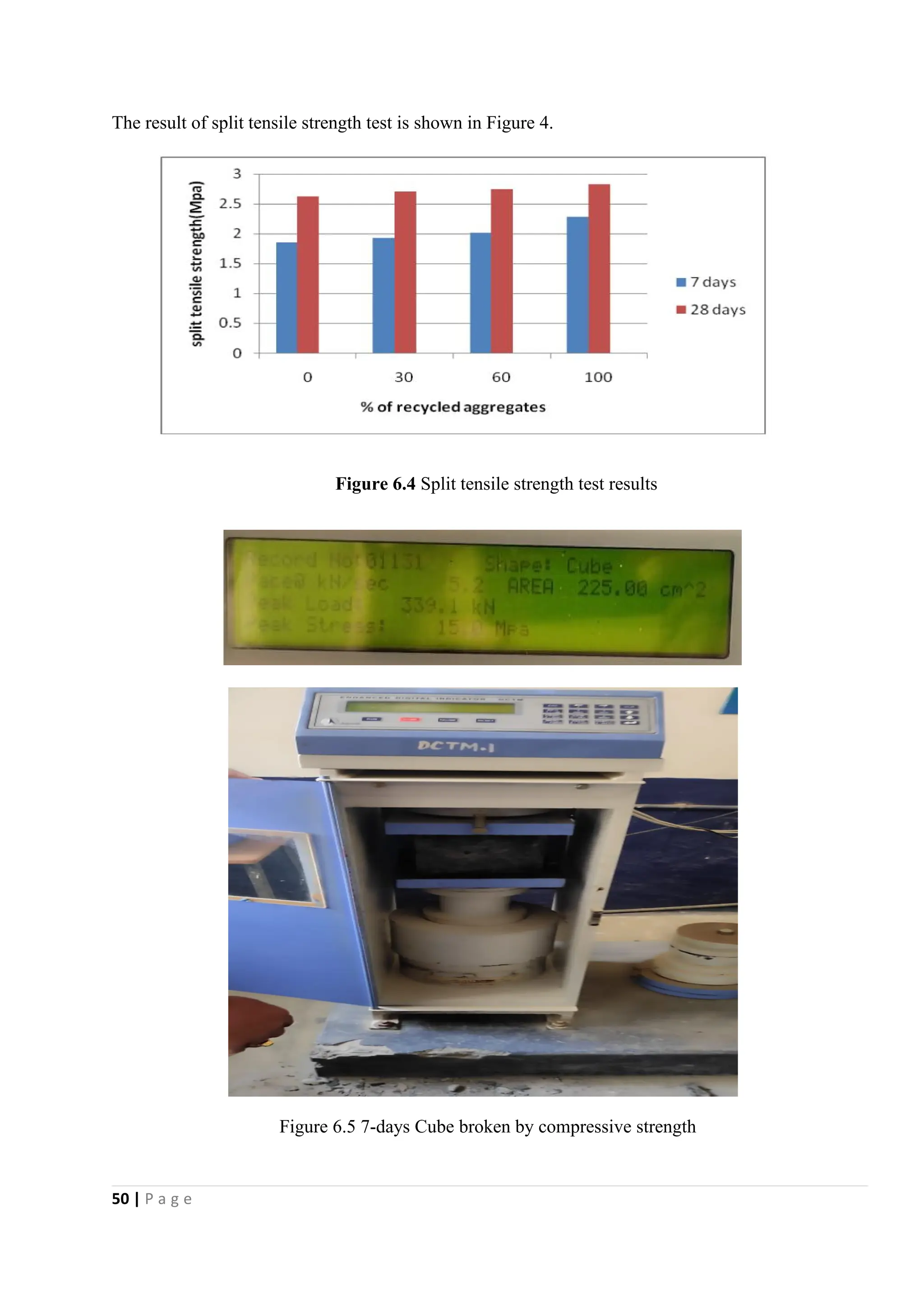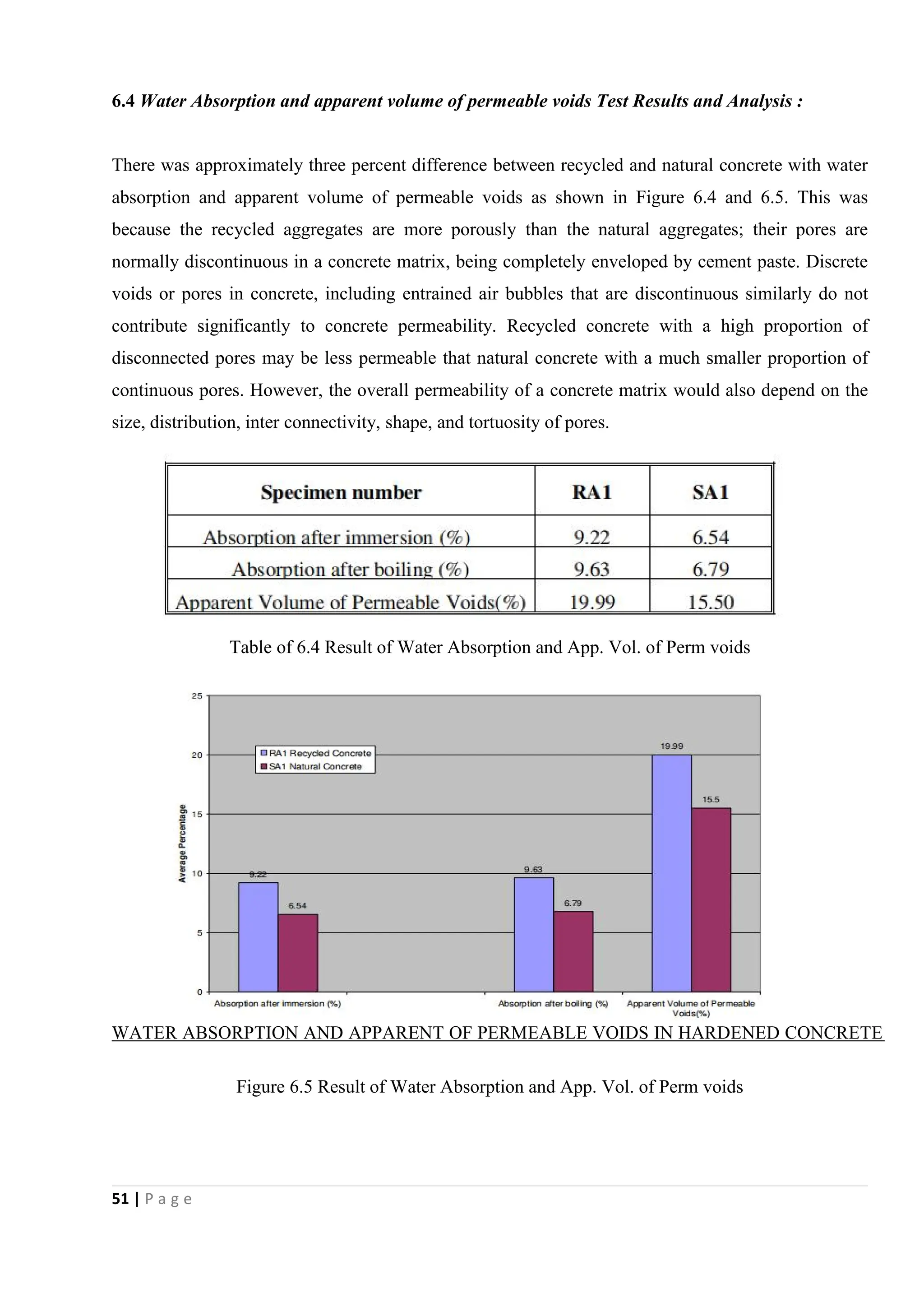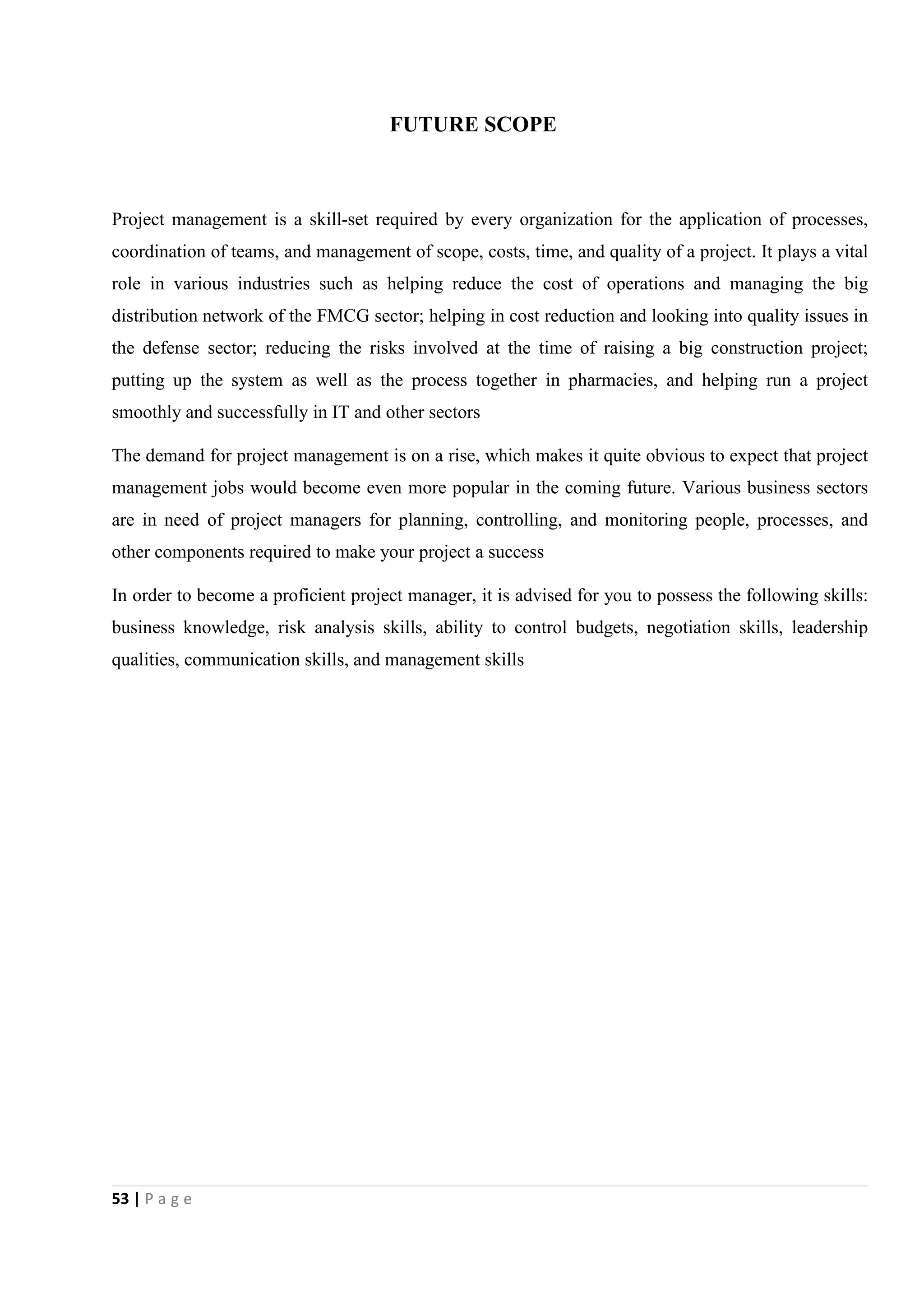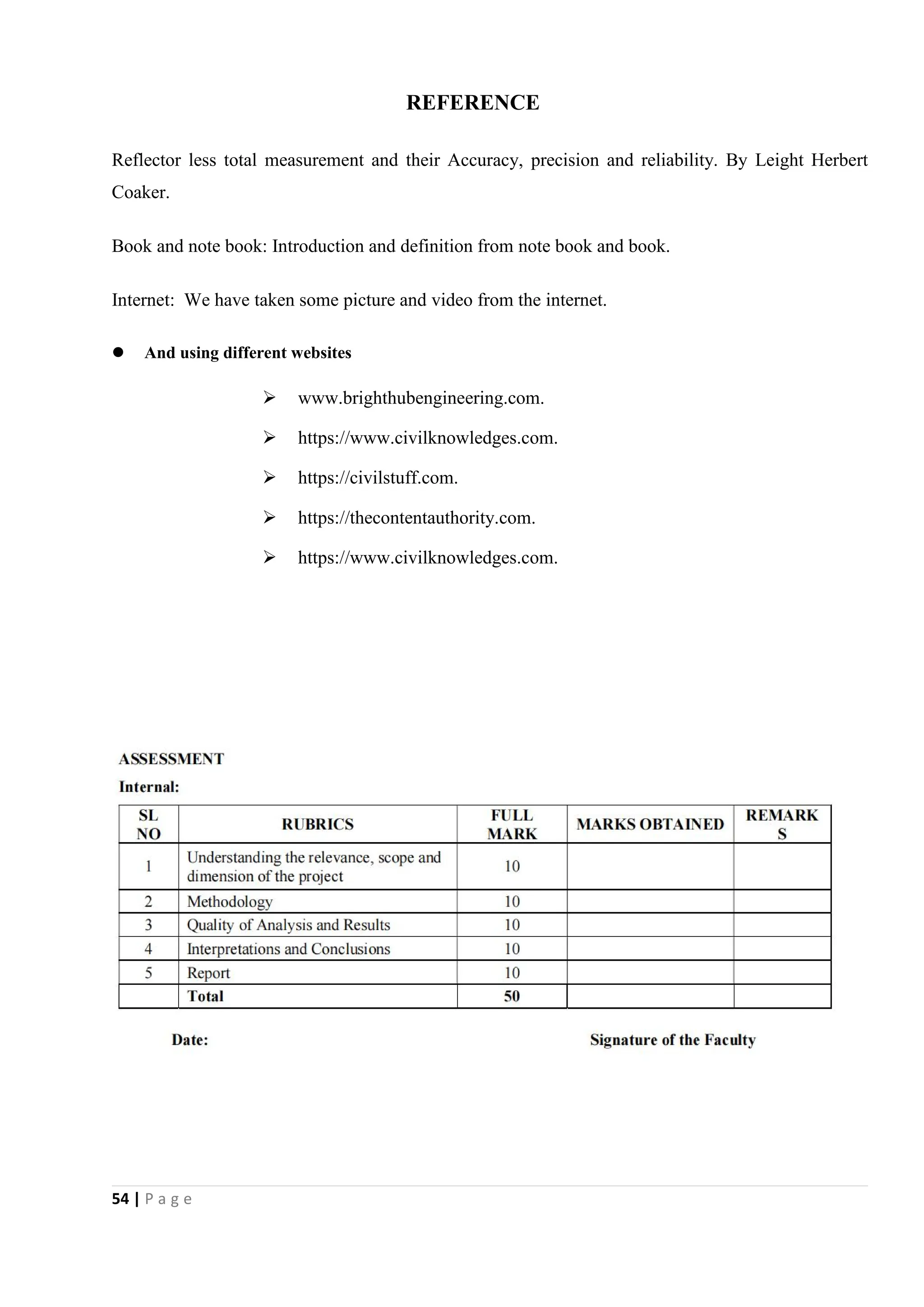The document is a project report on the recycling of aggregates from construction waste, presented by a group of students at Centurion University in Odisha. It outlines the significance of using recycled concrete aggregates (RCA) to conserve natural resources and mitigate environmental impacts, detailing methodology, treatment methods, and applications. The report emphasizes the advantages and challenges of RCA, advocating for its use in structural and non-structural concrete applications, while highlighting the need for proper mix design and quality control.
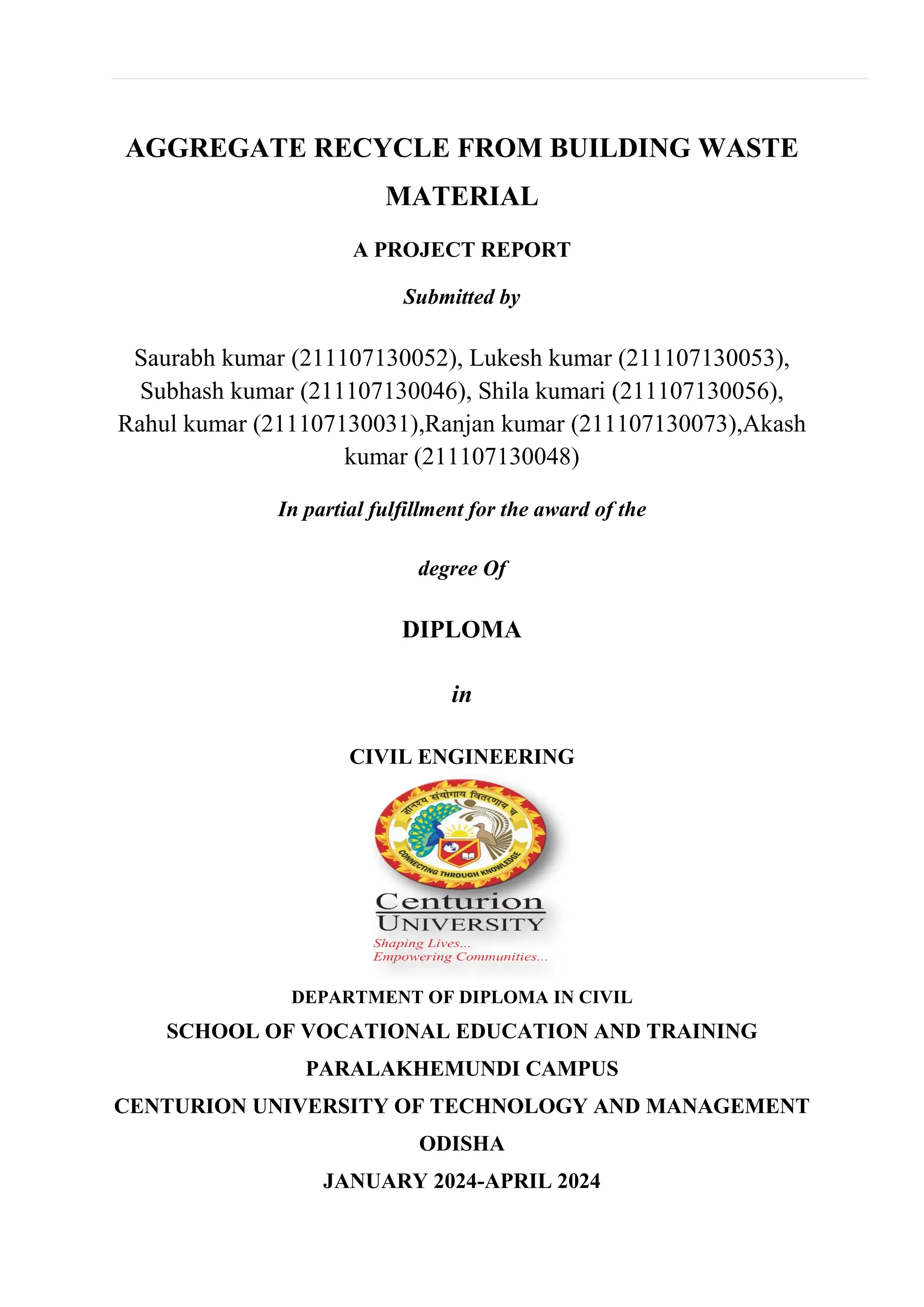
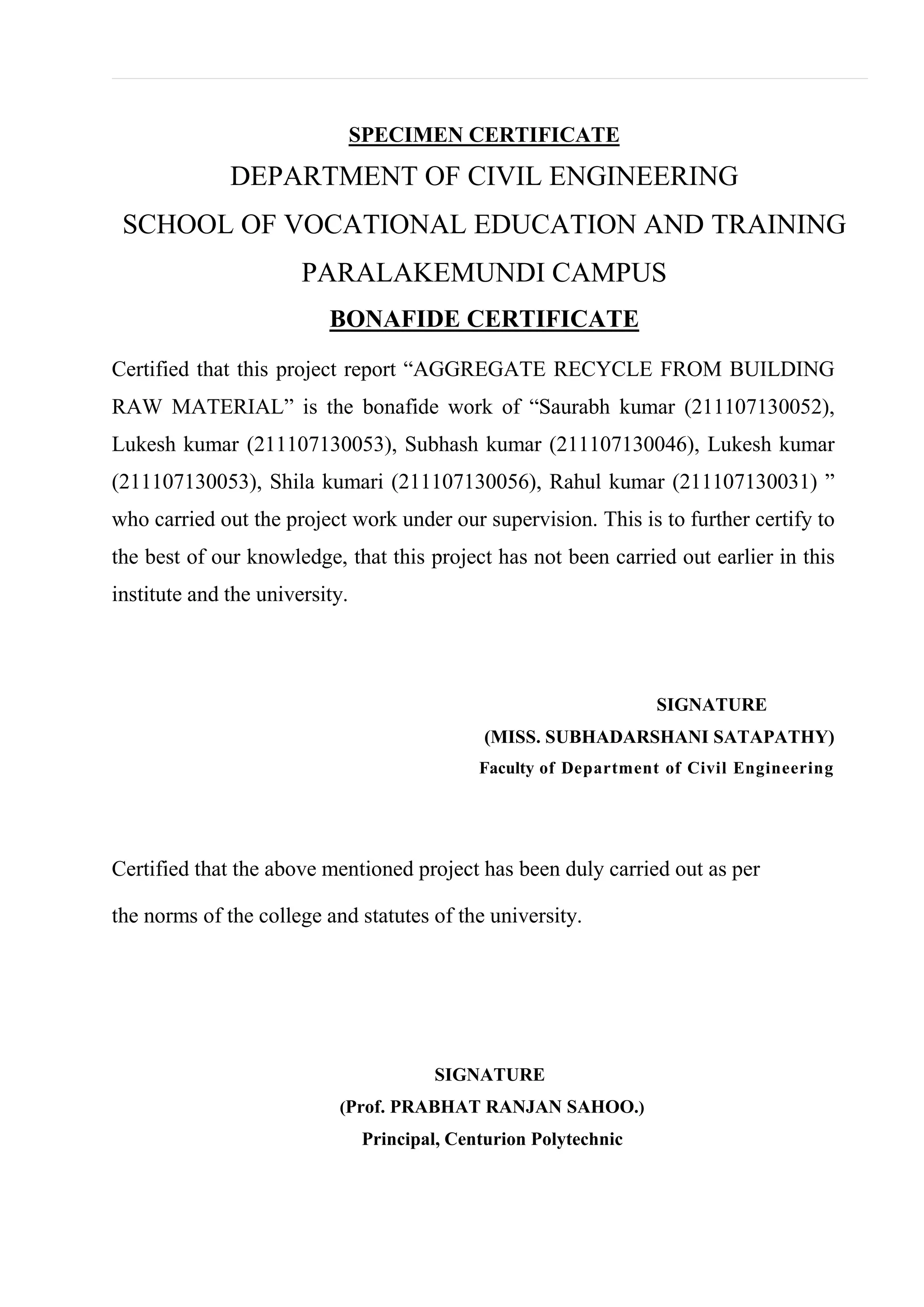
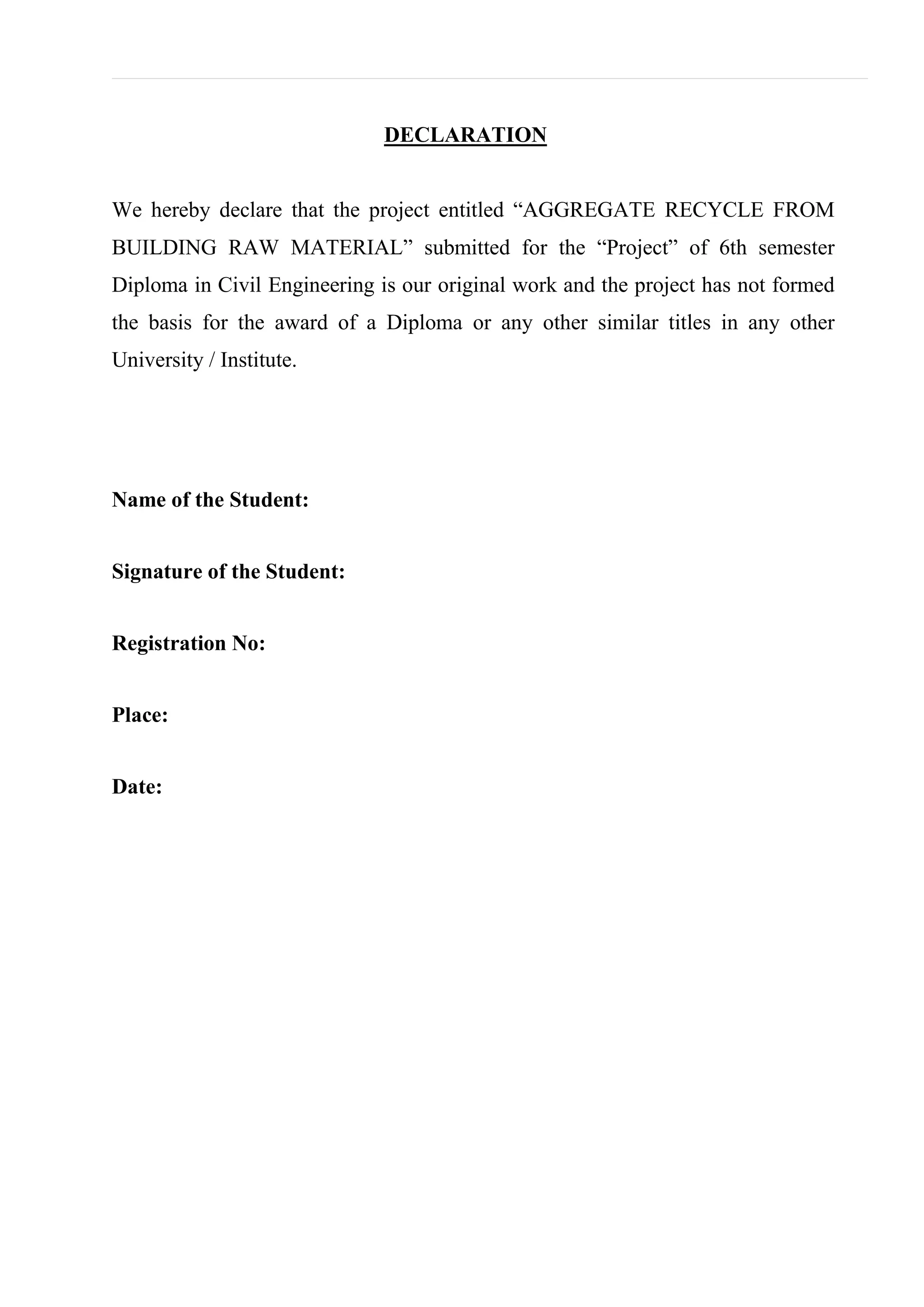
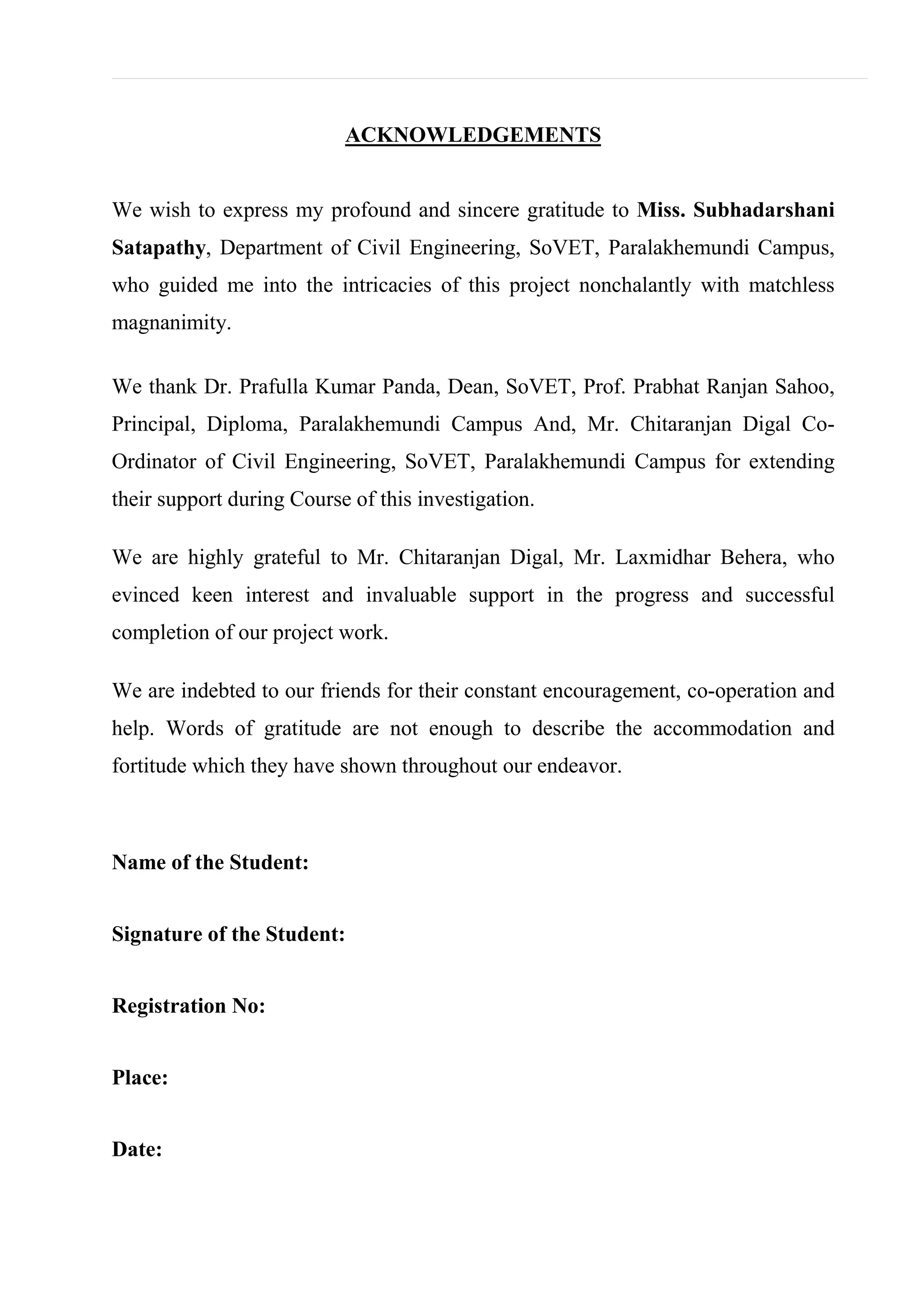

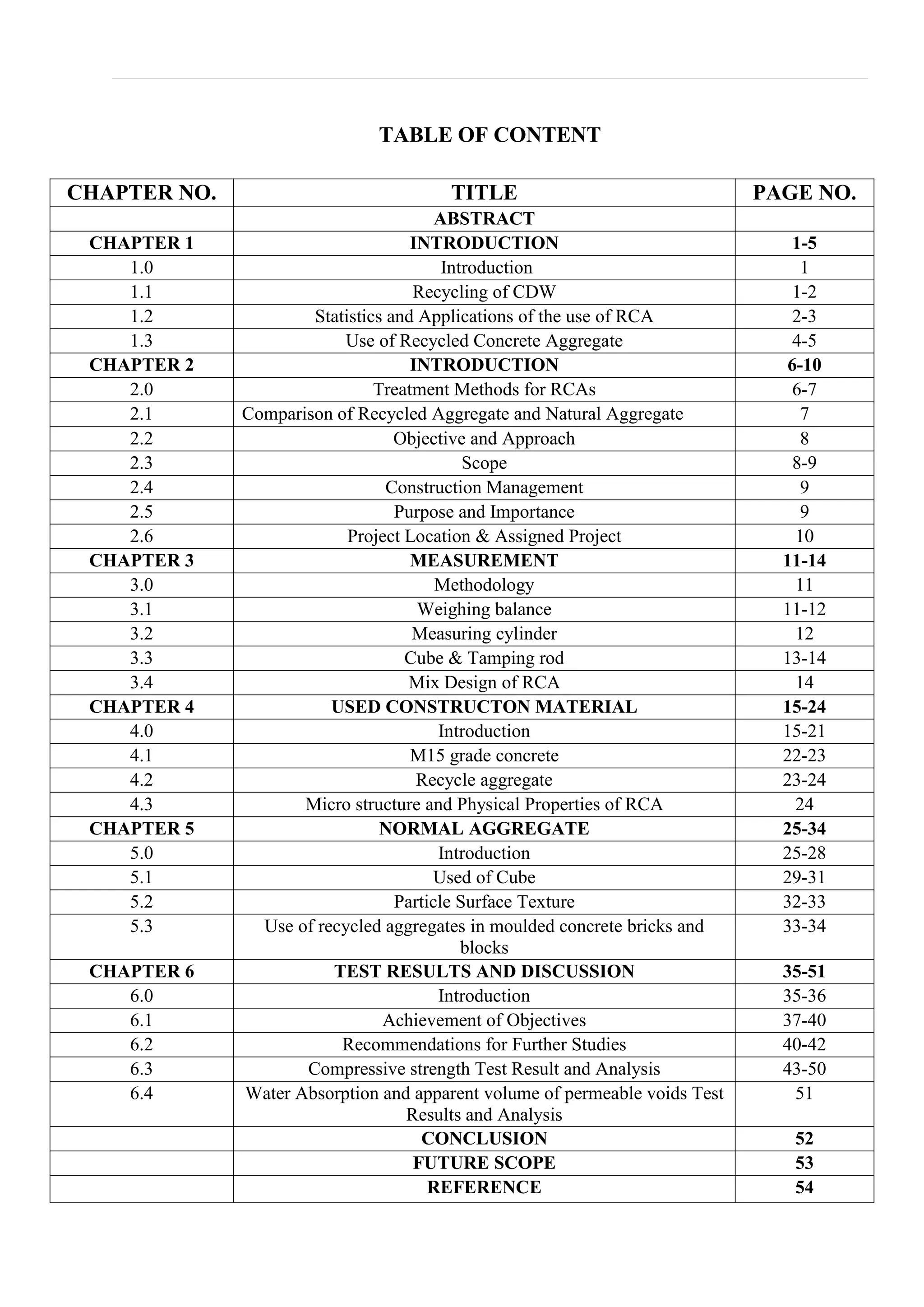
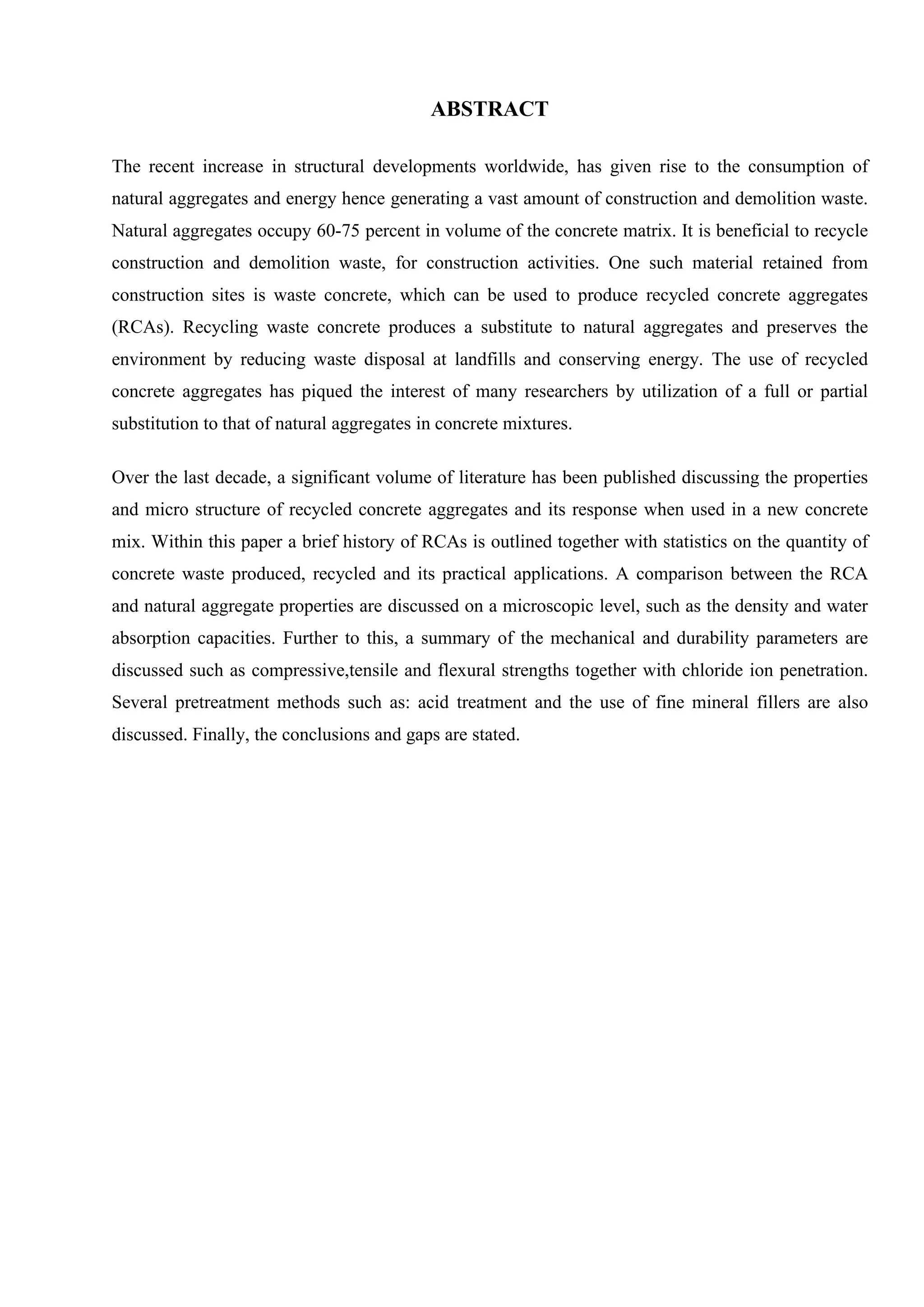

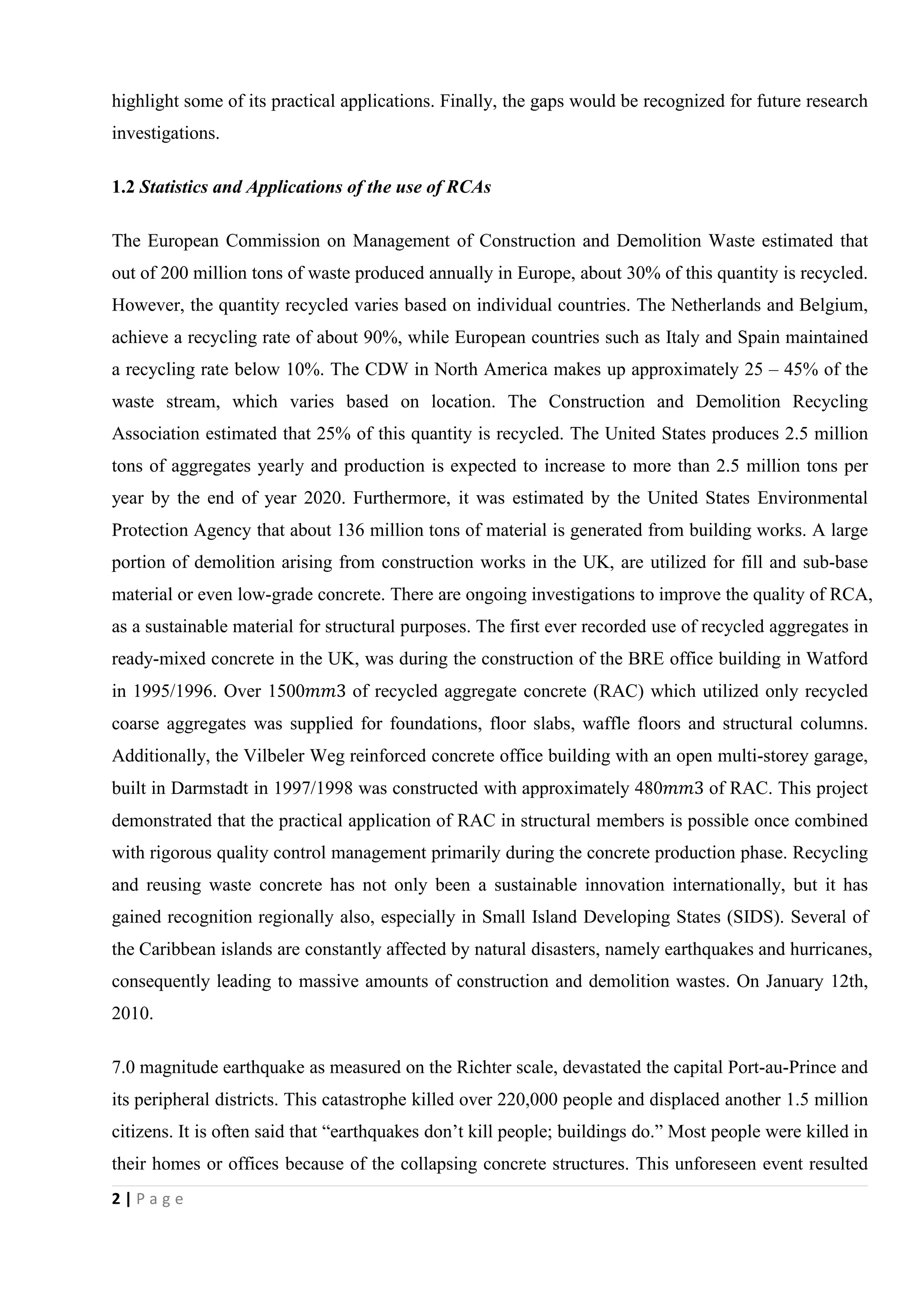
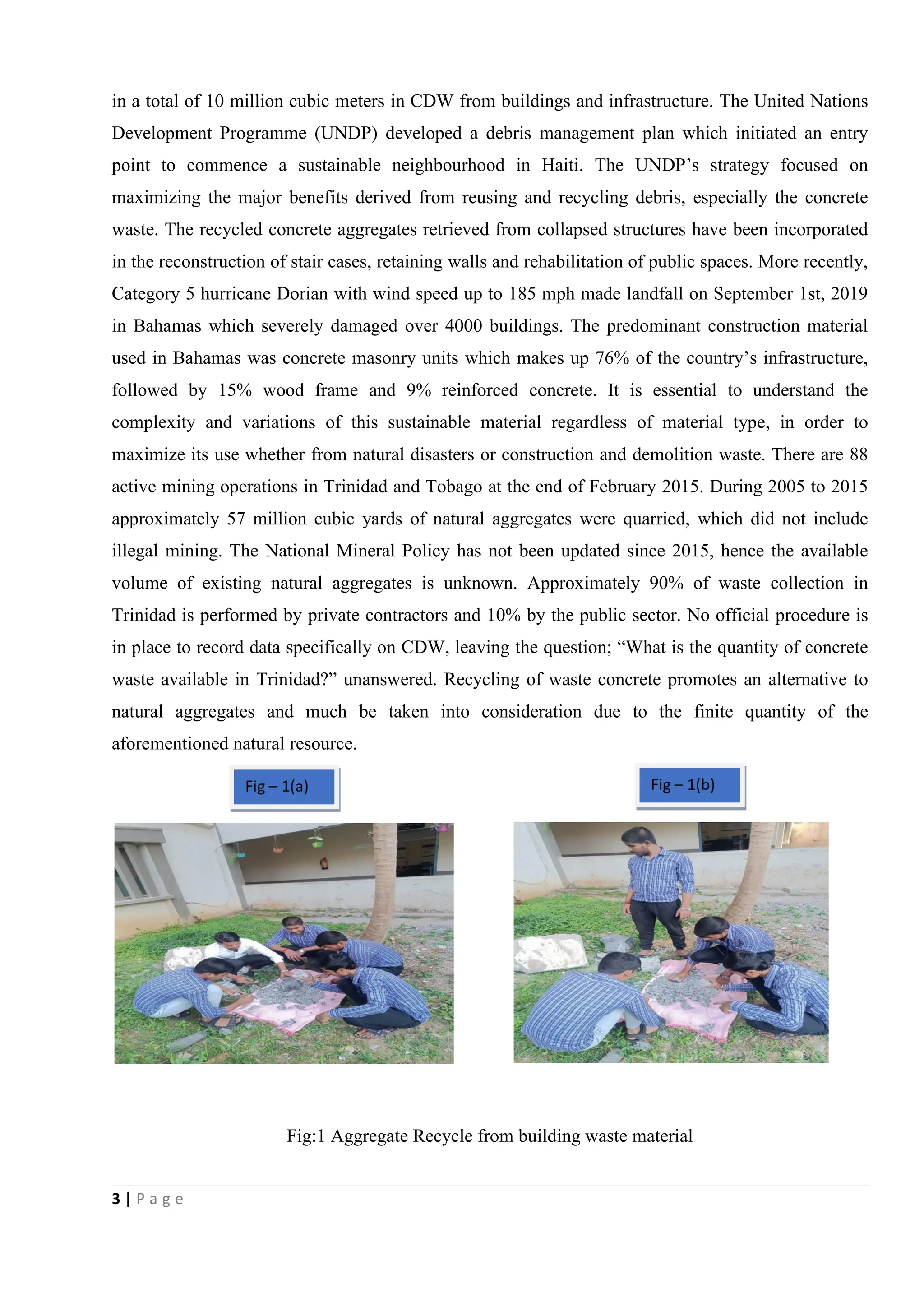
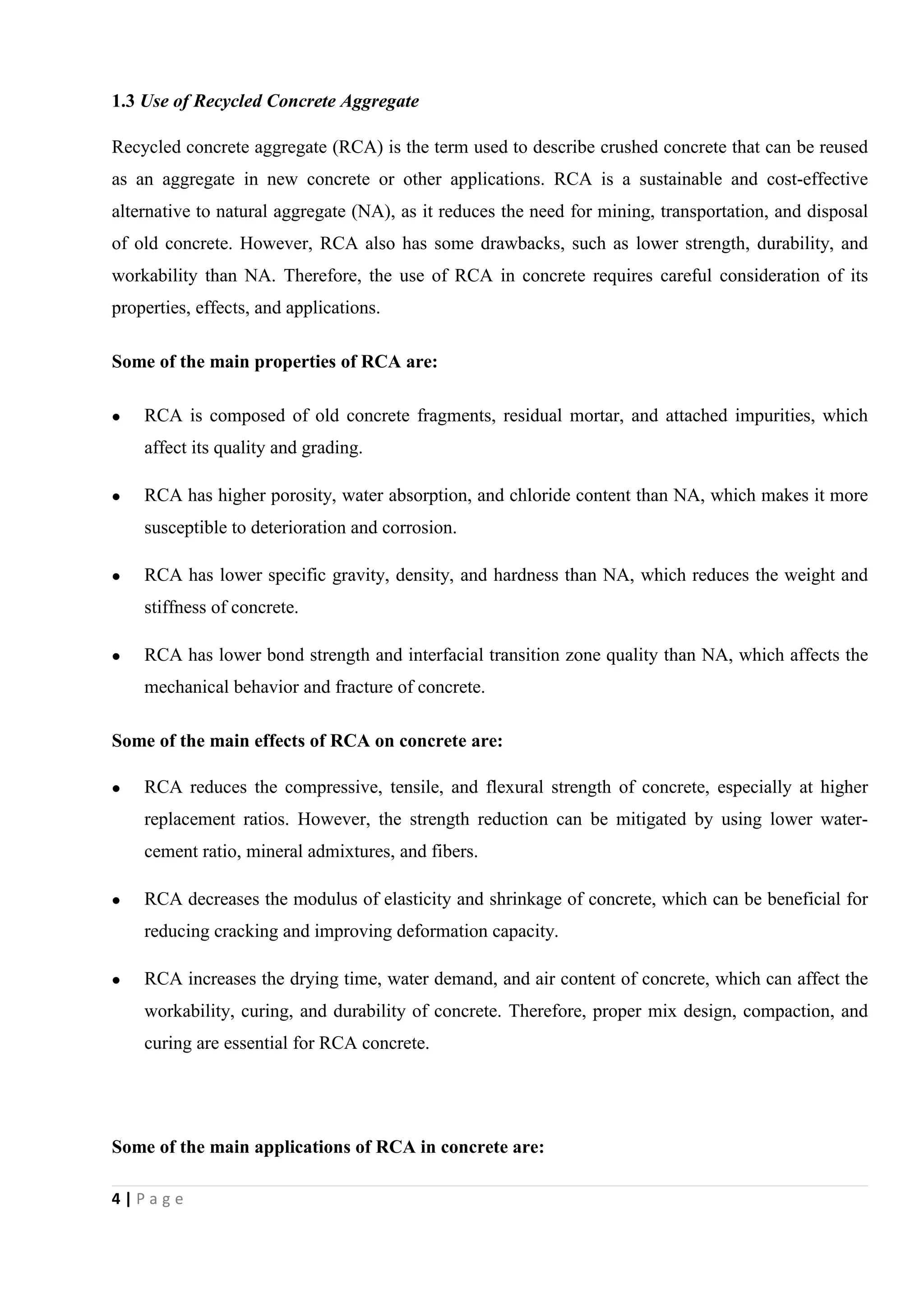
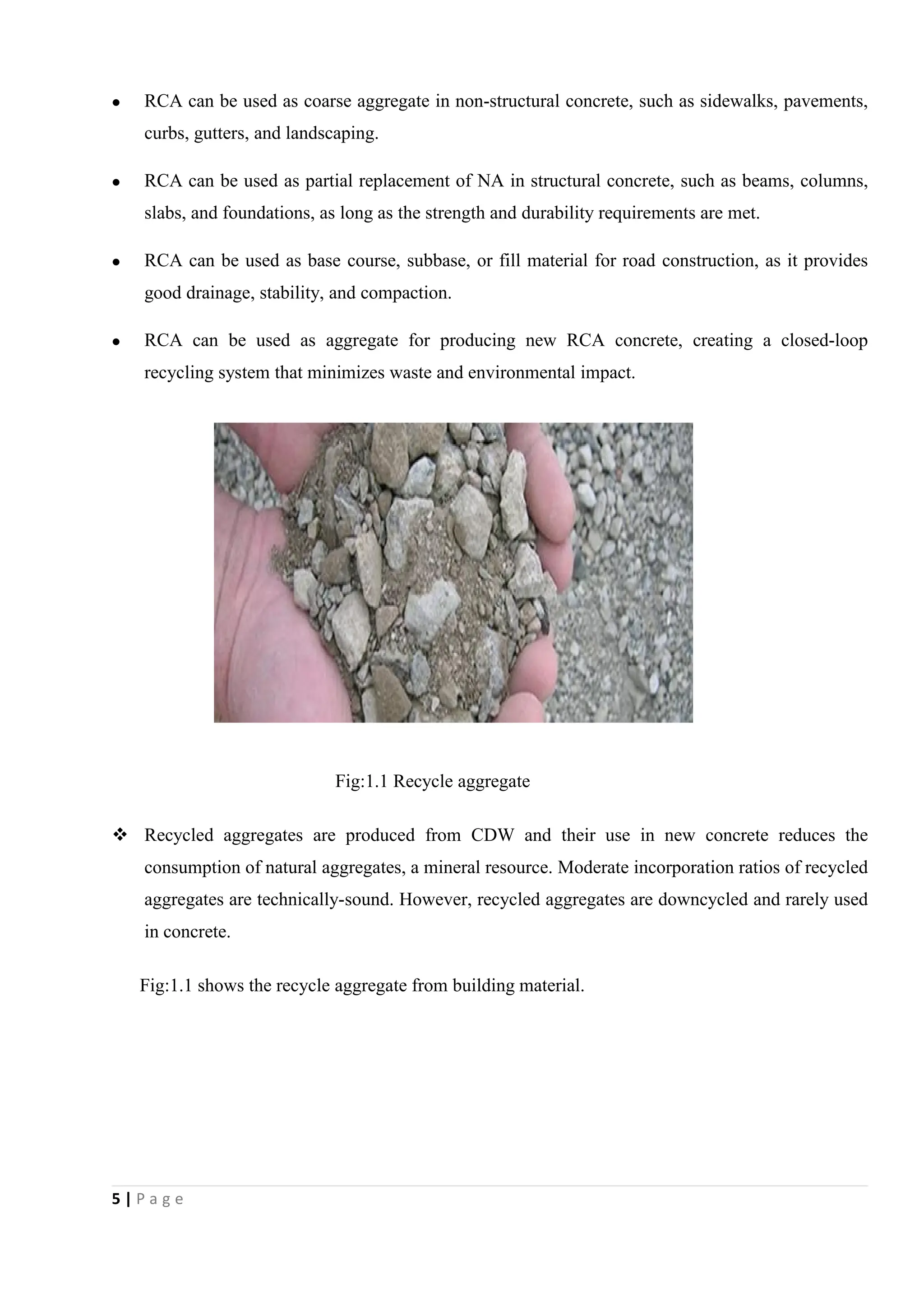
![6 | P a g e
CHAPTER-2
INTRODUCTION
2.0 Treatment Methods for RCAs
Several treatment methods have been established by researchers over time that has improved the
inferior properties of recycled concrete aggregates. The literature outlined several approaches which
fall into two categories: 1) removing the attached residual mortar on the surface of the RCA by pre-
soaking approaches and 2) modifying the surface and interior by using fine mineral materials. For the
first approach, several physical and chemical experimental methods were proposed. A measured
mass of coarse recycled concrete aggregates was fully submerged in 0.5M hydrochloric acid (HCL)
for 24 hrs which resulted in a 3% mortar loss. This acid treatment enhanced the physical and
mechanical properties of the RCA as compared to the untreated recycled aggregate. This
enhancement was a result of the removal of the weak attached mortar which produced a stronger
bond at the ITZ between the new mortar matrix and the RCA. There was an increase in concrete
strength where the treated- RCA was 96% of the control mix and untreated- RCA was 86% of the
control mix at 28 days. An increase in density and a reduction in water absorption was also observed
[48]. Similarly, the use of different acid solutions was used by another investigator, to pre-soak the
RAs for 24 hours at controlled conditions. Using HCL, a loss of mortar of 1.5% was observed, using
nitric acid (HNO3) there was a 2.5% loss and 5.6% loss for sulphuric acid (H2SO4) treatments
respectively. H2SO4 acid was identified as the effective solution, which removed the adhered mortar
to an extent. Recycled aggregates were obtained from a recycling plant in Hong Kong in which the
researcher used 30% replacement together with acid treatment to improve the overall porosity of the
RCAs. Before pretreatment the water absorption percentage of the RA was 1.65%, however after
exposure to an acidic environment for 24 hours the water absorption rates significantly reduced.
Before pre-soaking treatment, the water absorption for 20mm RCA was 1.65%, however after acid
treatment the water absorption capacities were 1.45%, 1.48% and 1.53% for hydrochloric acid,
sulphuric acid and phosphoric acid respectively. Additionally, the mechanical properties showed
improvements after pre-treatment. At 7 days compressive strength testing there was a 22%
improvement with 20% RA substitution, 23% improvement with 25% replacement recorded for
flexural strength and 21% improvement with 30% substitution for modulus of elasticity when
hydrochloric acid was used [23]. Polyvinyl alcohol (PVA) was also used as a solution to treat the
RCA. The PVA was sourced in its powder form to prepare different concentrations of polymer
solution using two litres of water. It was observed that the air-dried aggregates had a lower water](https://image.slidesharecdn.com/aggregaterecyclingfrombuildingrawmaterial1-240305180425-dae68749/75/Aggregate_recycling_from_building_raw_material-1-pdf-13-2048.jpg)
![7 | P a g e
absorption than the oven-dried aggregates when treated with 10% PVA. In general, there was a 1%
decrease in compressive strength as compared to the natural aggregate mix, using the air-dried
aggregates submerged in PVA. This could have been attributed to the infilling of the pores and
cracks with the new cement paste, hence improving bonds and healing the crack openings at the ITZ.
On the other hand, the oven-dried PVA- RCA yielded a lower strength because of the attached
chains of the PVA on the surface of the RCA aged by the temperature. The second approach involves
the use of non-reactive fine mineral admixtures, acting as fillers to enhance the RCA surface and to
strengthen the ITZ of the RCA. Together with the acid treatment, Ismail and Ramli (2014) further
treated the RCA by impregnation of calcium metasilicate (CM) solution which slightly increased the
particle density and significantly decreased the water absorptivity. These changes were attributed to
the coating formed by the CM particles over the surface of the RCA. This coating acts as a protective
barrier over the surface and refills the minute pores and cracks which improved the bond of the ITZ
between the surface of the aggregate and the mortar matrix [48]. Katz (2004), also investigated
treatment using silica fume in addition to the ultrasonic cleaning. There was 15% increase in as
compared to the untreated recycled aggregate. The recycled aggregates impregnated in the silica
fume (SF) solution results in the SF particles penetrating the cracks of the aggregate. This improves
the ITZ by the filler effect of the SF particles. This improvement extends from the original natural
aggregate through the old and new mortar matrices.
2.1 Comparison of Recycled Aggregate and Natural Aggregate
It is important to be aware of the difference between recycled aggregate and natural aggregate
(refer to Figure 2). This way the differences can be taken into account and possibly mitigated
when using recycled aggregate in concrete mixes.](https://image.slidesharecdn.com/aggregaterecyclingfrombuildingrawmaterial1-240305180425-dae68749/75/Aggregate_recycling_from_building_raw_material-1-pdf-14-2048.jpg)
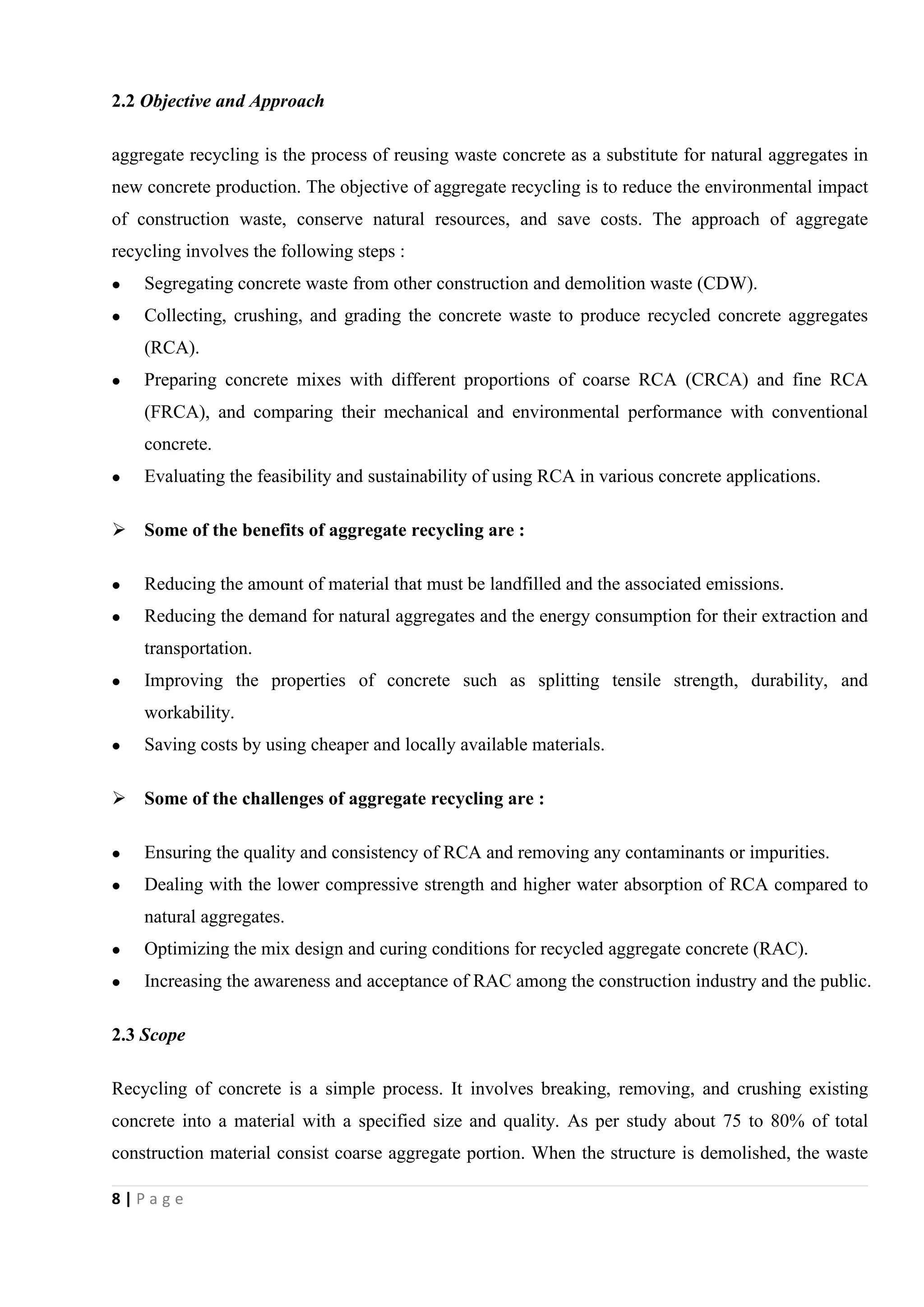
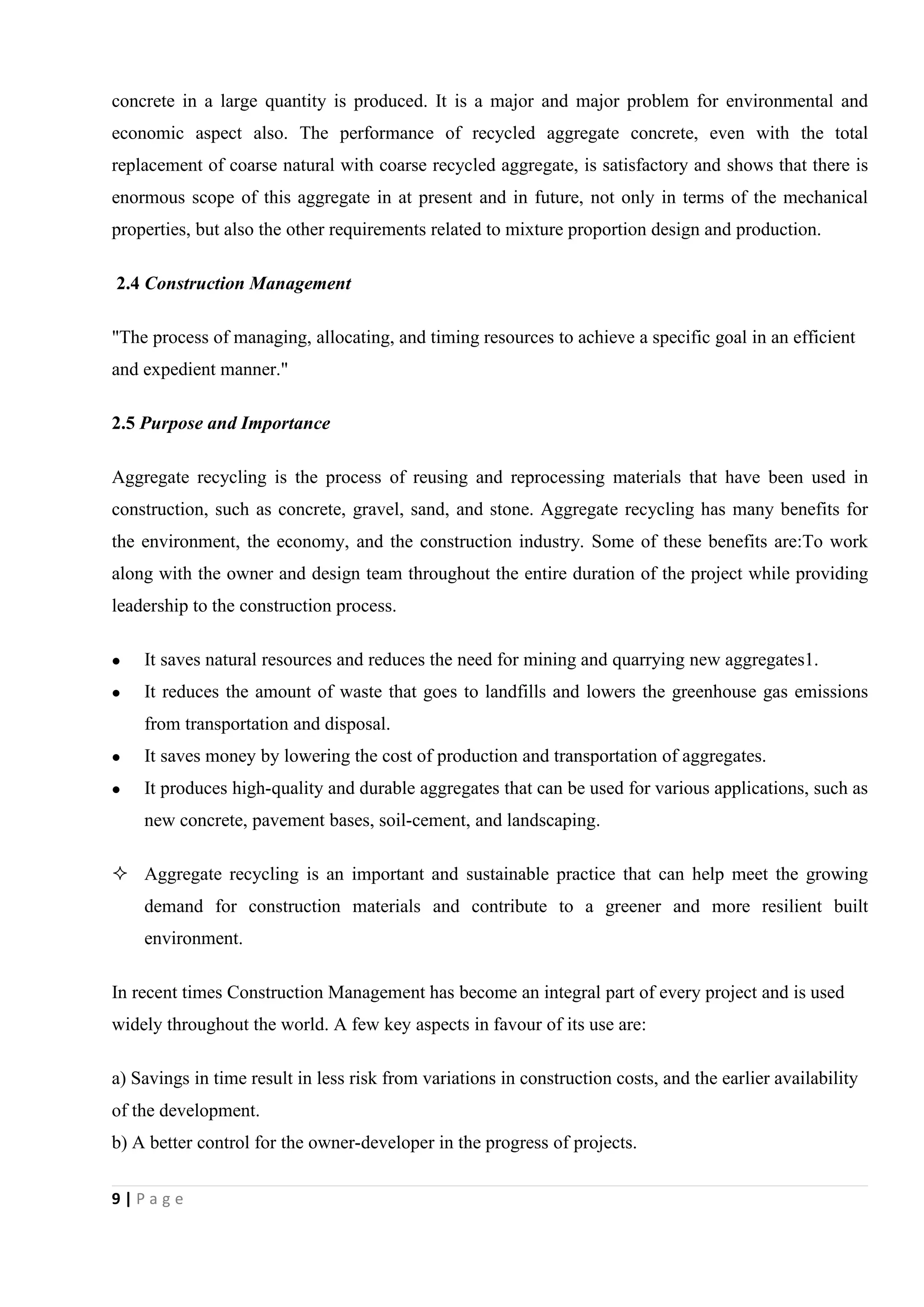
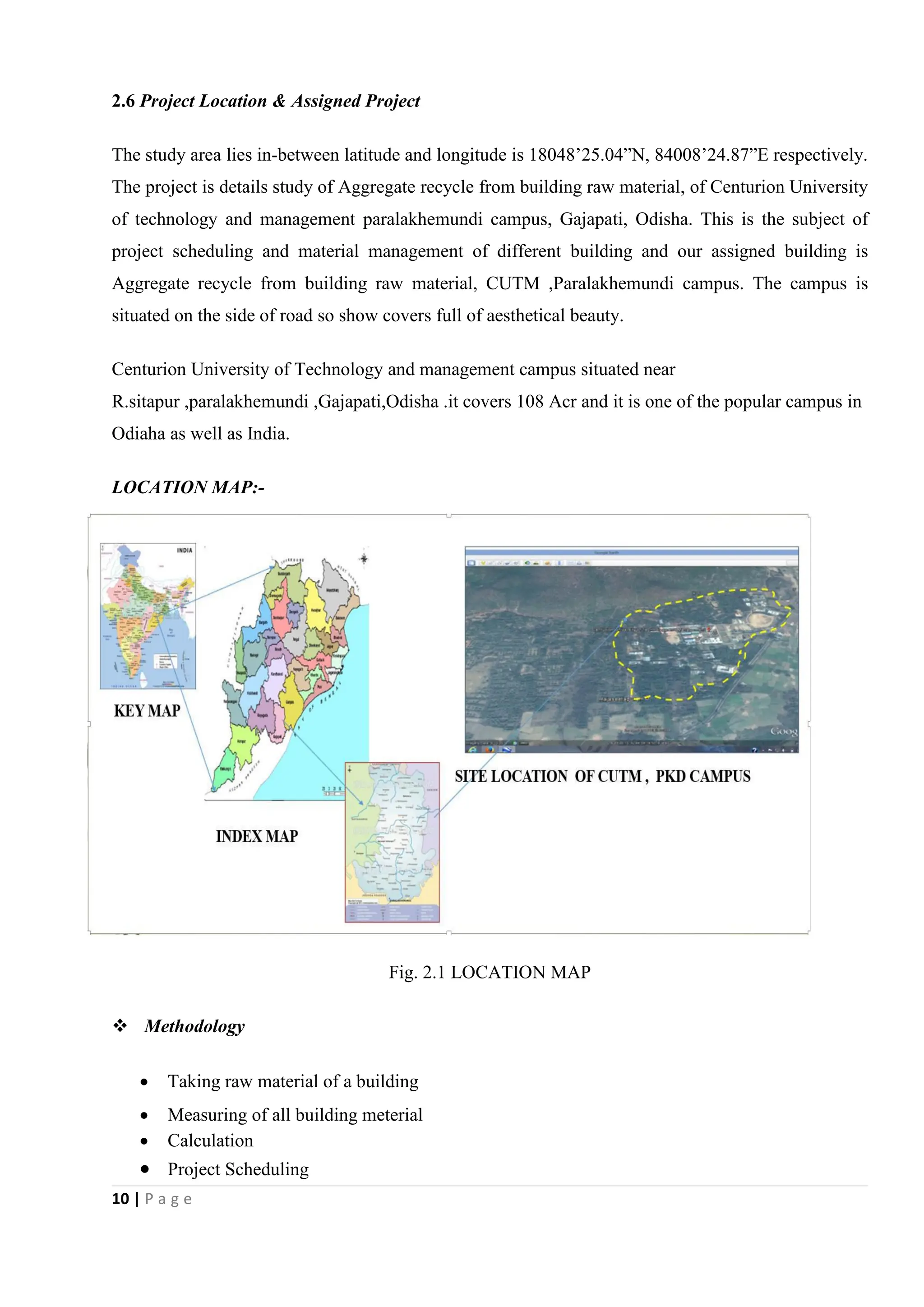
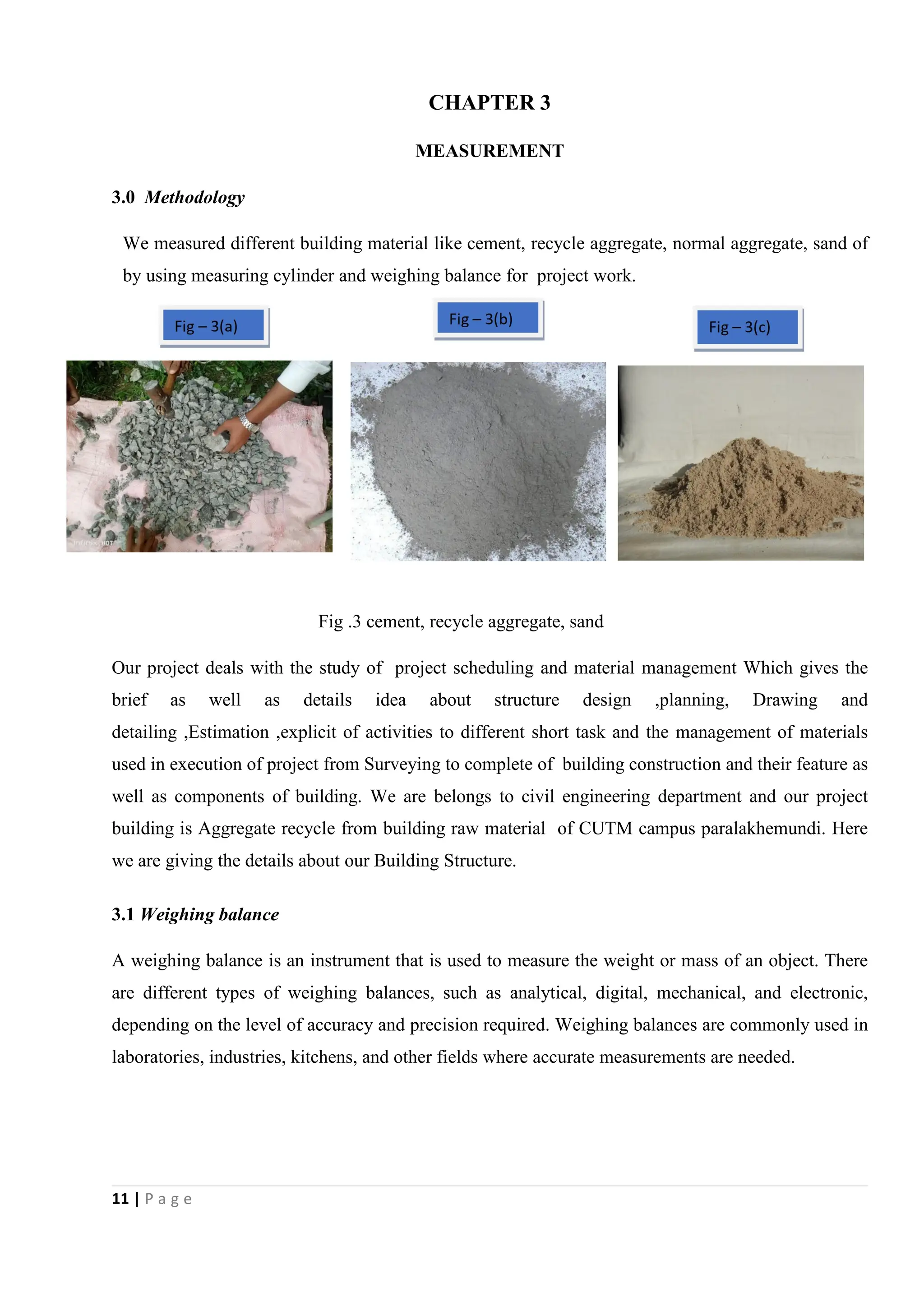
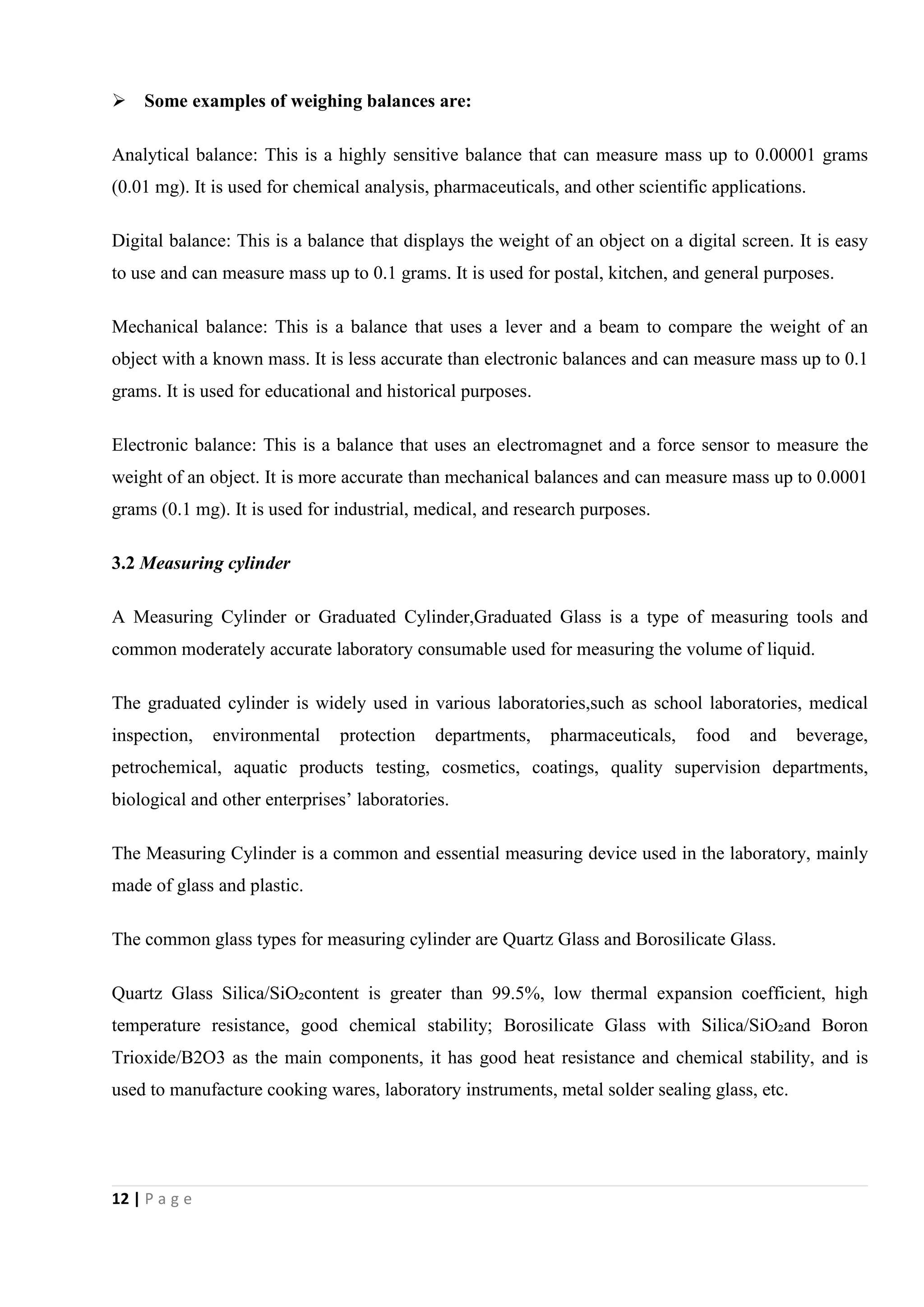

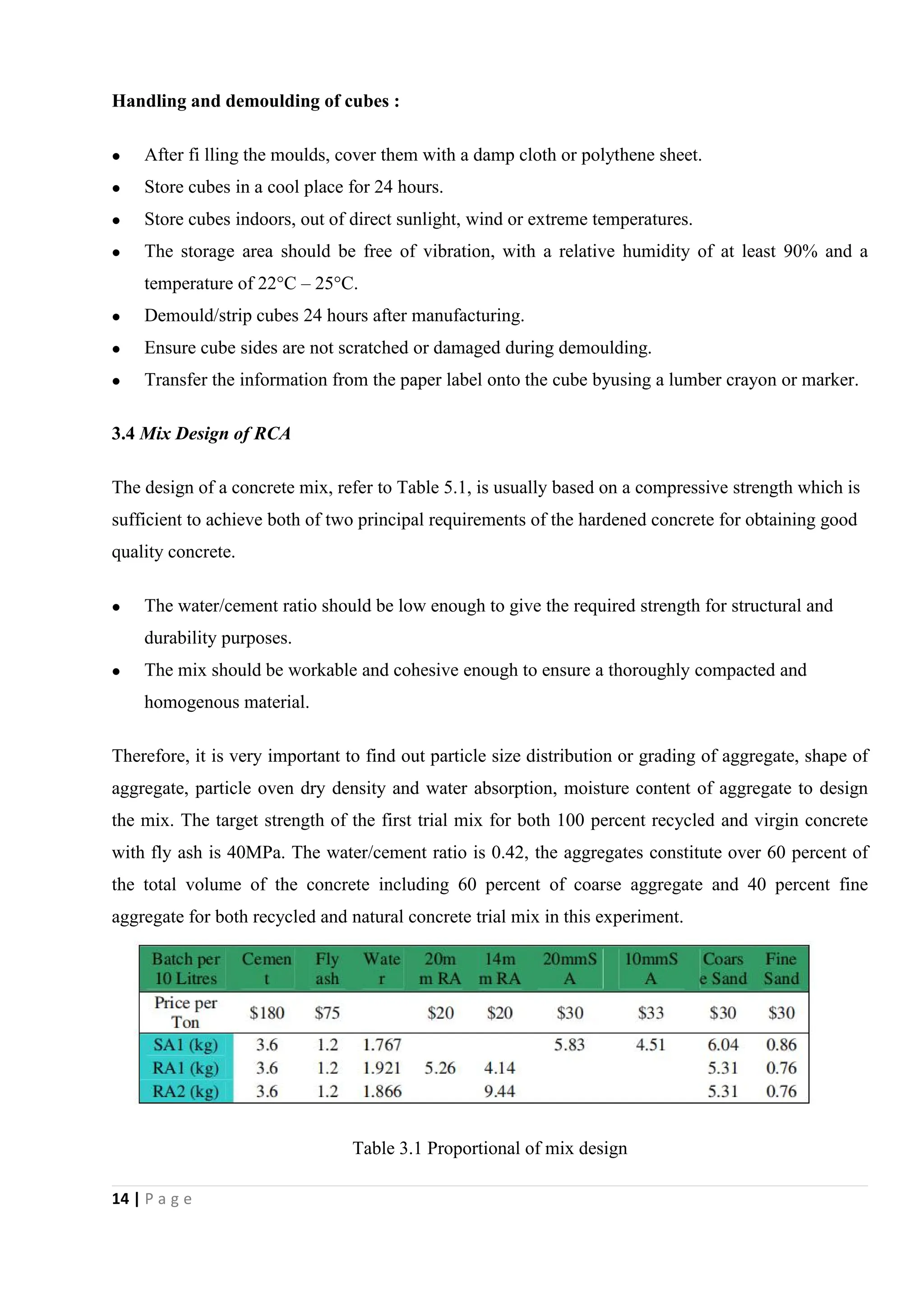
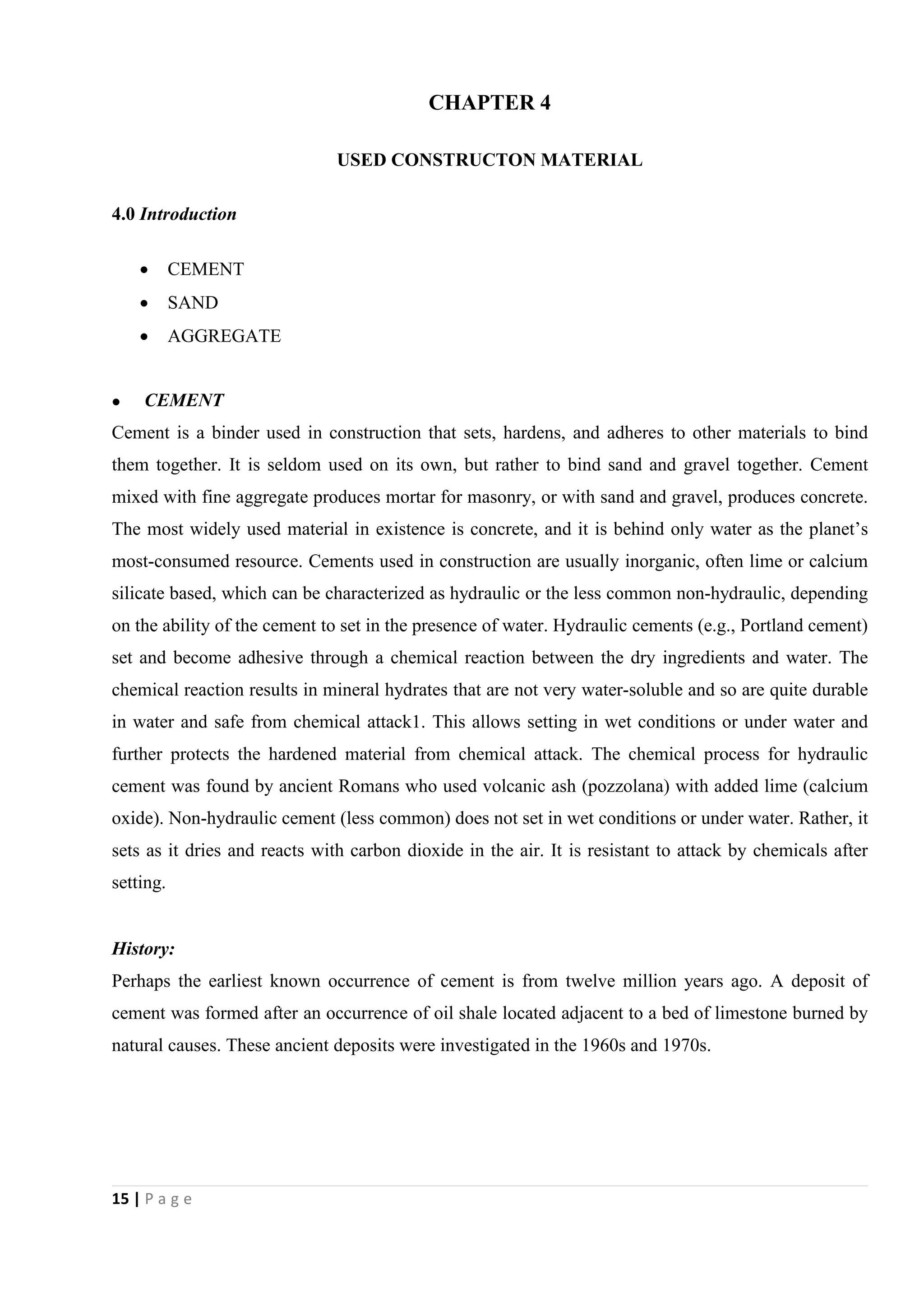
![16 | P a g e
Safety issues:
Bags of cement routinely have health and safety warnings printed on them because not only is
cement highly alkaline, but the setting process is exothermic. As a result, wet cement is strongly
caustic (pH = 13.5) and can easily cause severe skin burns if not promptly washed off with water.
Similarly, dry cement powder in contact with mucous membranes can cause severe eye or respiratory
irritation. Some trace elements, such as chromium, from impurities naturally present in the raw
materials used to produce cement may cause allergic dermatitis.[53] Reducing agents such as ferrous
sulfate (FeSO4) are often added to cement to convert the carcinogenic hexavalent chromate (CrO42−)
into trivalent chromium (Cr3+), a less toxic chemical species. Cement users need also to wear
appropriate gloves and protective clothing..
Components of cement:
comparison of chemical and physical characteristics
Fig:4.1 comparison of chemical and physical characteristics](https://image.slidesharecdn.com/aggregaterecyclingfrombuildingrawmaterial1-240305180425-dae68749/75/Aggregate_recycling_from_building_raw_material-1-pdf-23-2048.jpg)
